WHOLE NO. 274


WHOLE NO. 274


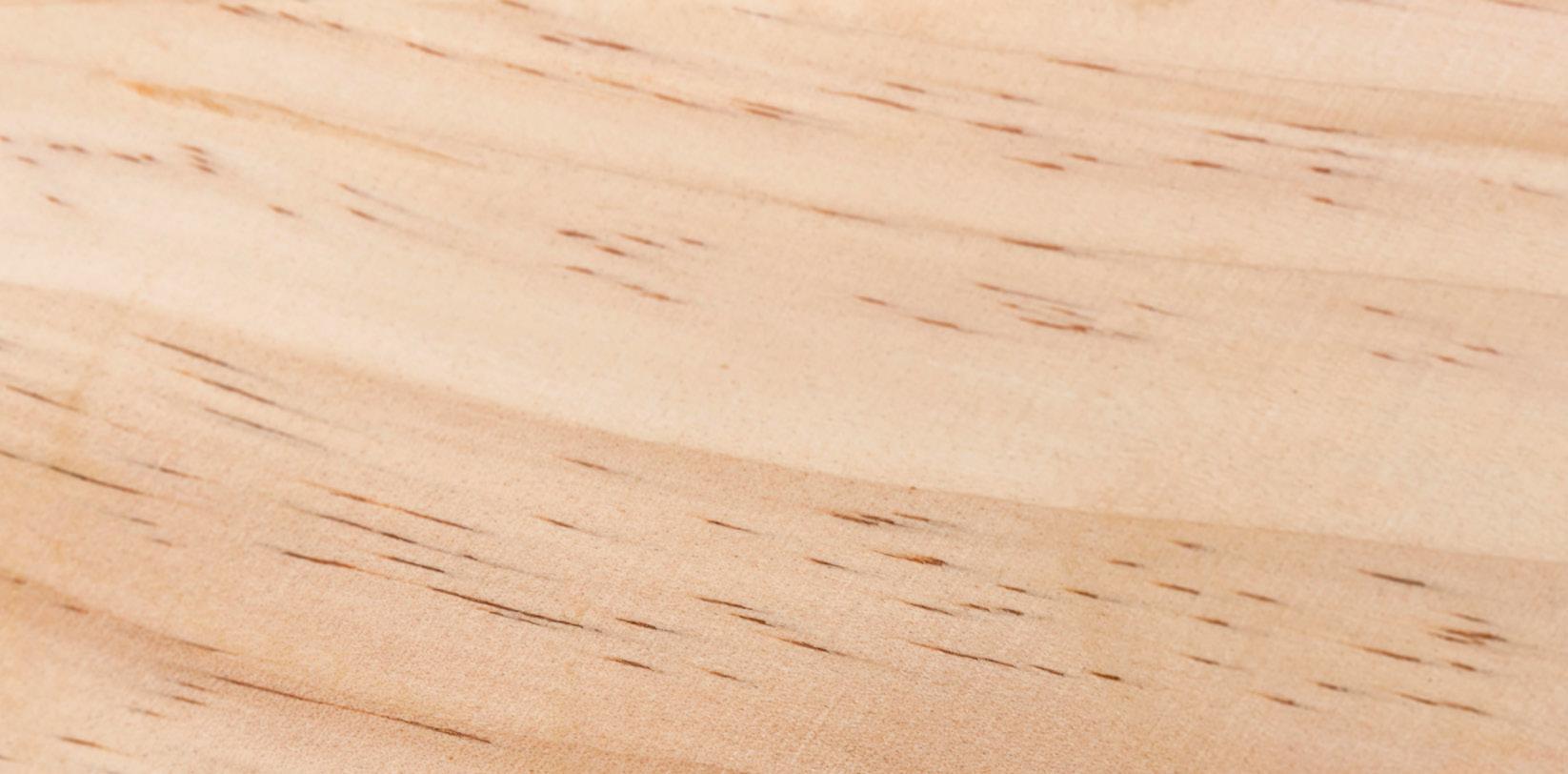



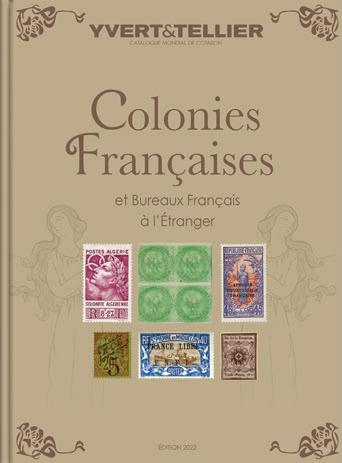

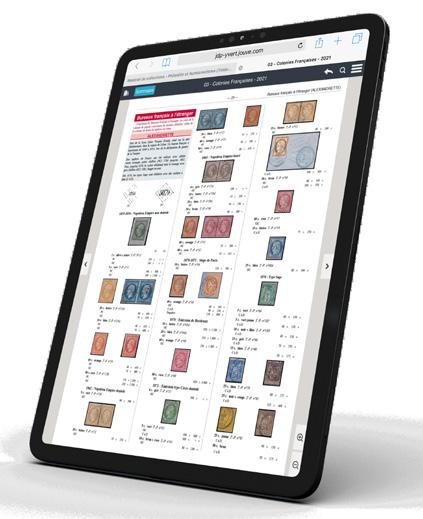
For more than 100 years, YVERT & TELLIER has been the worldwide reference for collectors. With a range of stamp catalogs of more than 1,000,000 references, created over the years, we accompany philatelists in their passion every day.
YVERT & TELLIER also offers a digital version of its catalogs.
The e-catalogue is a tool available to the collector to consult the stamp quotation catalogs.

 Stamps dealer and catalog editor since 1896
Stamps dealer and catalog editor since 1896
15 IN MEMORY OF GINI HORN
Gini Horn, who passed away in February, headed the APRL for 25 years until her retirement in 2010.
20 QUICK GUIDE TO STANLEY GIBBONS CATALOGS, By APS and APRL staff and Richard West APS staff offers insights into the history of the large family of Stanley Gibbons catalogs and how to use them as a reference work.
27 AN INCOMPLETE REVIEW OF SPECIALIZED SOCIETY CATALOGS, By Susanna Mills
A survey of just a few APS-affiliated specialty societies reveals the depth of philatelic research published every year.
36 THE IMPORTANCE OF THE 1915 FORBIN WORLD REVENUE CATALOG, By Ron
LesherThe popular collecting area of worldwide revenue stamps was ignored by major catalog publishers for more than a century, even though a work from the early 20th century laid the groundwork of how to do it right.
40 TRIALS, TRIBULATIONS AND GOOD FORTUNE OF THE (AERO) POSTAL HISTORY STUDENT, By Dr. Jerzy W. Kupiec-Weglinski
The author tells his personal journey in researching and writing a book that explores the development of airmail from 1914 to 1939 in his native country and its vital role in Europe.
48 A LOOK AT NORTH AMERICA’S FIRST PHILATELIC PERIODICAL, By
Brian J. BirchThe Stamp Collector’s Record, published in February 1864 by philatelic rogue Samuel Allan Taylor, has very few surviving copies. Birch details their locations and shares the high points of this first issue.
55 THE REFERENCE NOTEBOOK, By Marsha Garman
The APRL’s reference assistant explains her “broad strokes” approach to tracking down clients’ needs.
JOURNAL
FIRST
100 Match Factory Place Bellefonte, PA 16823
Phone: 814-933-3803
Fax: 814-933-6128 plrarticle@stamps.org
ADMINISTRATOR & PUBLISHER
Scott D. English • scott@stamps.org
EDITOR-IN-CHIEF
Susanna Mills • smills@stamps.org
SENIOR EDITOR
Jeff Stage • jstage@stamps.org
GRAPHIC COMMUNICATIONS SPECIALIST
Chad Cowder • ccowder@stamps.org
ASSOCIATE EDITOR, LIBRARIAN & DIRECTOR OF INFORMATION SERVICES
Scott Tiffney • stiffney@stamps.org
ADVERTISING SALES
Steve Schwanz
Fox Associates, Inc. 800-345-8670 x 114 adinfo.theamericanphilatelist@foxrep.com
©American Philatelic Research Library, 2021
Philatelic Literature Review (USPS 928-660, ISSN0270-1707) is published quarterly by the American Philatelic Research Library, Inc. (APRL). Telephone: 814-933-3803; Fax: 814-933-6128; E-mail: plr@ stamps.org; Website: www.StampLibrary.org.
Postmaster: send address changes to the APRL, 100 Match Factory Place, Bellefonte, PA 16823. Periodicals postage paid at Bellefonte, PA 16823, and additional entry offices.
Annual subscription rates: $21, regular members; $30, sustaining members; and $50, contributing members. Libraries and institutions, $30. Single copy price, $5.


The January 2022 issue of The American Philatelist focused on catalogs, and as you flip through the pages of this issue of the Philatelic Literature Review, you may notice that topic is once again a subject for discussion. When Scott Tiffney mentioned that this issue would continue looking at catalogs, I began thinking about some catalogs that have an important place on my bookshelf.
I made a quick stop at my American Heritage Dictionary to check the definition of a catalog, the first of which is “a list or itemized display as titles, course offerings, articles for exhibition or sale, usually including descriptive information or illustrations.” The lists and illustrative material in philatelic catalogs are generally the stamps, cancels, auxiliary markings and covers we have or seek to add to our collections.
Perhaps you are like me and when you come upon an unfamiliar item, you want to know what you have. Is it a single item or part of a set? Are there varieties, and if so, how might you tell them apart? In addition, do you, like me, consult a catalog in the hopes of learning something of our philatelic items’ value or scarcity?
As a collector of cinderella material, one of the catalogs I turn to frequently is James N. Drummond’s Catalog of Philatelic Miscellany. This three-part color catalog published in 2016 lists a wealth of unusual cinderella material. Let me offer three examples of the range of items that Drummond examines.
First, he has a listing of United States hotel stamps. Shown (Figure 1) are two examples

of stamps issued to promote the completion of Chicago’s Hotel Sherman in 1911. Drummond lists the stamp in six different colors, in perf. 11½ and roulette 7. He notes that he has only seen the perforated versions in green and black as well as purple and black. The rouletted stamps can be found in all six color varieties. The perforated stamps are priced at $75 for the two perforated varieties he has seen and $2 each for the rouletted stamps. The catalog provides useful information for the collector, illustrating each of the known copies, listing the varieties, and providing an estimate of value.
As I was writing this column, I thought I’d visit eBay to see if any Hotel Sherman stamps were being offered. My search re-
vealed one copy of the rouletted purple and black Hotel Sherman stamp with a “Buy It Now” price of $12.95. Drummond’s catalog certainly provides guidance for a collector seeking to put together a small collection of these stamps, while at the same time making sure not to overpay when doing so.
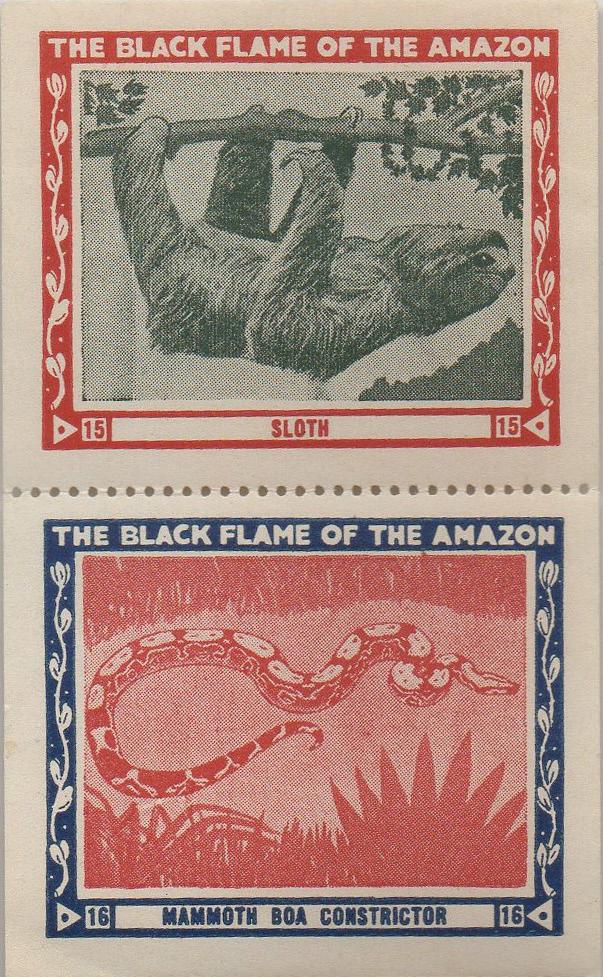
Second, Catalog of Philatelic Miscellany offers some detailed coverage of stamps given away by gas stations and petroleum companies. Hi-Speed gas stations offered pairs of “The Black Flame of the Amazon” stamps to customers in 1939 (Figure 2). The stamp promotion was linked to a radio series of the same name that took explorer Harold Noice and a small team of adventurers through the Amazon. Hi-Speed stations provided a map of


APRL BOARD OF TRUSTEES
PRESIDENT
Ken Grant
VICE-PRESIDENT
Greg Galletti
SECRETARY
Melanie Rogers
TREASURER
Ken Nilsestuen
PAST PRESIDENT
Roger Brody
TRUSTEES
Thomas Bieniosek
Hugh Lawrence
Hugh McMackin
Kristin Patterson
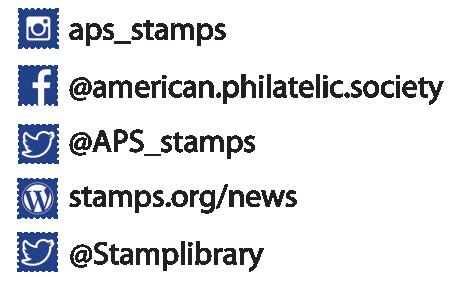
South America with places for each of the stamps to be affixed. Drummond prices each of the stamps at $4 as singles; an eBay search shows four of the 24 stamps priced at $5 or Best Offer.
In another section, Drummond tackles space stamps, listing a range of them produced in Great Britain, Canada and the United States, some 27 pages of listings.
A Canadian firm, Modern Publications, of St. Catharines, Ontario, produced a sheetlet of 12 stamps labeled “Interplanetary Postal Essays” (Figure 3) and denominated in novas and pecunes. [Note: a nova is a strong, increased brightness of a star; the definition of pecune is unclear, though it did mean “wealth” in Middle French.] They were
intended to be sold at the Seattle World’s Fair in 1962. My sheetlet is missing the top selvage identifying it as the Interplanetary Postal Essays.
The point in all this may be that as philatelists gain familiarity with their collecting specialties, they may not rely on their catalogs as much, feeling they are in control of that aspect of their material. However, when the items under scrutiny are unusual or previously unknown to the collector, then the right catalog really proves its value, providing context for the individual and his latest acquisition and letting him or her know that the purchase was a sound one.
Ad Sizes: Full Page • Half Page • Quarter Page
Ad Deadlines: 2nd Quarter, April 17
3rd Quarter, July 17 • 4th Quarter, October 17 Contact Steve Schwanz, Fox Associates, Inc. for 2022 advertising rates. See below contact information.
Display advertisers will be invoiced upon publication of their ads.
Dealer Directory Listing in the 1st and 3rd Quarter issues is FREE to advertisers who have a display ad in these issues, otherwise there is a $25 listing fee.
Clearinghouse Ad Rates: $3 per listing with a maximum of 10 items per submission. Items selling for greater than $100 are $7 per listing. Payment MUST accompany all Clearinghouse ads.
For information: Steve Schwanz, Fox Associates, Inc. Phone: 800-440-0231 x114
E-mail: adinfo.theamericanphilatelist@foxrep.com

CCG is hiring top stamp experts to expand its stamp authentication and grading services to the United States. If you are knowledgeable and passionate about stamps, now is your opportunity to build the leader in third-party authentication and grading.
The CCG companies include the world’s largest grading services for coins (NGC), paper money (PMG) and comic books, trading cards, magazines and concert posters (CGC). Together, they have certified nearly 70 million collectibles since 1987.
A great catalog makes collecting so much more fulfilling. –
How do you build a themed magazine issue about stamp catalogs?
Former APS Editor-in-Chief Gary Loew and I struggled with this question for months as we developed the concept of the January 2022 issue of The American Philatelist. There was never any doubt in our minds as to the importance of this theme, or its relevance to readers. For most collectors, a philatelic catalog is the first book they add to their bookshelves – a reference for all that exists to collect and how to identify it, and a guide for purchasing.
As I noted in my column of the January issue, catalogs give us a shared language to talk about our collections, both general and deeply specific, and offer a blueprint for how to collect them. Do you organize your collection based on the Scott catalog system, including back of the book? Do you prefer a town-by-town organization of your postal history collection, based on a specialized catalog? The catalogs you use and your collections are intertwined and deeply personal.
This project came with some challenges, however.
The first of these is scope. We realized immediately that the issue could only cover postage stamps, not revenues, nor postal stationery, nor postal history. Even fitting a solid representation of postage stampfocused catalogs into a single issue proved impossible, however – which brings me to the second problem: choosing coverage.
A list of the top countries collected by APS members eased this matter – of course,
Eugene Denson, APS memberwe would prioritize the countries that more collectors would be interested to see. Gary also developed a geographical region list to ensure that our coverage would not be a “popularity” contest alone. Countries with more complex and interesting philatelic histories would be considered as well.
As we began to solicit reviews from experts of our chosen countries, we ran into some further difficulties. When our Israel reviewer had a family emergency and was not able to contribute at the last minute, we had no back-up. We asked several authors if they could help cover independent Africa – and while eventually we met Peter Thy, who wrote a review of post-colonial British Africa catalogs, we were not able to share the full coverage we had hoped.
This, as a side note, has raised several questions in my mind. Why was it so hard to find multiple experts on the literature of these areas? Was it a simple problem of our failing to locate and ask the right people? Are there plenty of people who could have written these reviews, but they are not members of the APS? Or is there just not enough interest in those specific country collecting areas? I find the last very hard to believe, as it implies a very U.S.-centric way of thinking about organized philately. But without isolating the problem, it is hard to develop a useful solution.
Perhaps our lack of members who collect certain areas affects how we prioritize the resources we share. Perhaps a shortage of resources in certain areas affects who
wants to join the APS. It is a chicken and the egg conundrum.
As we wrestled with questions of scope and coverage for the January issue, we developed a few solutions.
The first of these is the Catalog Reference Hub, a new feature on the APS website (www.stamps.org/catalogs). The Hub currently has the full-length catalog reviews that appeared in excerpted form in the January issue, and as time goes on will include other catalog reviews that appear in The American Philatelist and the PLR, articles about using catalogs, links to online APS courses through the C3a platform, and links to relevant library resources. The Hub is currently designed to sort reviews geopolitically, but as we continue our catalog coverage, more complex sorting and index-
ing methods will be available.
Which brings me to the other solution: continued coverage of catalogs in print. This first PLR issue of the year was always intended to be a joint issue with the January edition of The American Philatelist It continues the theme, offering more catalog book reviews, a brief guide to using the Stanley Gibbons family of catalogs, and a lengthy listing of publications published by specialty collecting societies. But your responses already have proven that this subject is very important to you, and that our coverage should not end there.
I’ll give a few examples. In October, we sent a request via the weekly APS newsletter for members to tell us about their favorite specialized stamp catalogs. We received over 70 responses. I’ve shared a few below.
Dai Nippon Catalogue of the Postage Stamps of The Republic of Indonesia
It is not possible to collect Indonesian revolutionary stamps without the Dai Nippon catalog. Scott [catalogs] only lists 139 of the thousands of stamps available, most of which are hand stamped overprints of Netherlands Indies issues or Japanese occupation issues. Scott does mention that some stamps “bear handstamps previously applied by local authorities during and after the Japanese occupation. Such multiple-overprinted stamps command prices that may be more or less than the values shown, which are for examples without other overprints.”
MEMBER FAVORITESThis caveat is frequently ignored, however, by both small internet dealers and large auction houses. Scott 2L8 is routinely offered online for close to the catalog value of $100, without the seller or buyer being aware that the very common Japanese overprint on it reduces the value to about $5. Similarly, I have seen people pay hundreds of dollars for high priced emergency issues for Aceh when in fact the apparent postal cancellation on the stamp is actually a printer's cancellation indicating that it is printers waste. On the other hand, Scott 2L76, which is misidentified in Scott as having a value of 200r when actually it is 150r, can be worth triple or more of the catalog value if part of the overprint is 2 mm larger than usual. The collector would know none of all this without the Dai Nippon catalog.
The main problem with the catalog is that it has not been updated since 2005, so the prices can be pretty out of date. It is possible, though, to compare catalog prices for stamps listed in both Dai Nippon and Scott and come up with a rough “inflation multiplier.” No other catalog comes close to being comprehensive for these issues though, so this is the one you must have.
- Robert BrewMy favorite specialized catalog is The Stamps of Iran by N. Farahbakhsh [2021 Edition]. Although I specialize in the stamps of the Islamic Republic, there is such a wealth of information in the catalog, both historical and philatelic, on the Qajar and Pahlavi periods that I can literally sit down and read the catalog like a very interesting book. Moreover, I met the original publisher of the catalog, the noted Iranian philatelist F.N. Farahbakhsh, when he was passing through Bahrain on his way home from an international show in Singapore; we spent several hours in the souk drinking tea and discussing Iranian philately well into the night. A truly great catalog isn't just a detailed listing of stamps and their descriptions; it's a "book" that can also be read in its own right. The Stamps of Iran is just such a catalog.
- Emory Earl ToopsI would have to suggest, if not already considered, The State Revenue Catalog which is a 733 pages, hardbound book in color. It’s available from the State Revenue Society and several dealers and for those who thought state revenue stamps had no value and were not an interesting collecting field, the catalog could very easily change their minds.
- E. J. GuerrantRegrettably, we were only able to follow up on a few of these responses in time for the January issue. The takeaway, however, is that not only are collectors eager to share about their favorite catalogs, but they want other readers to be aware of them, want to
see them updated, and want to learn more about them. The same takeaways were clear from the letters we received after the January issue arrived in readers’ mailboxes. I’ll share a few more here.

I very much enjoyed your January issue of the The American Philatelist that included “The APS Definitive Guide to Stamp Catalogs.” I have always been a proponent of a collector obtaining as much literature as possible in order to gain the most knowledge about their collecting interest. One type of literature that a collector should add to their personal library is a catalog or catalogs that cover their area of collecting.
I was disappointed to see some catalogs missing from the section devoted to Scandinavia, starting on page 54. Though that section did an excellent job of reviewing the Facit catalogs, that section of the magazine should have included a mention of the following catalogs for country specific collectors:
AFA Catalog, which is a specialized catalog for Denmark collectors; LAPE Catalog, a specialized catalog for Finland collectors; Norma Catalog, another specialized catalog for Finland collectors; and Norgeskatalogen, a specialized catalog for Norway collectors.
Examples of these catalogs are in the American Philatelic Research Library and are available for borrowing.
Ron Collin River Grove, IllinoisOur local stamp club, the Rio Rancho (New Mexico) Stamp Club, is in the process of re-evaluating our club library and found the January catalogs issue to be very comprehensive and instructive. We found the articles to be well written, complete and literally covered the subject worldwide from a philatelic perspective.

We are canvasing our membership to better understand their collecting interests and determine if additional specialty catalogs may be needed. It seems that to date we’ve relied primarily on the U.S. Scott catalogs, especially the Scott Specialized, which does meet most of our members' needs. However, some of our members also have specialized interests and need catalogs that better meet their collecting interests.
Paul L. MortonSecretary, Rio Rancho Stamp Club
Rio Rancho, New Mexico
As you read these letters, peruse this issue, and reread the January AP, I have a challenge to set to you. Did you notice a lack in our coverage? Is there something you would like to learn more about? Do you have expertise using a specific catalog or in a collecting area that you would like to share? We cannot continue a concentrated effort to give catalogs their due – whether in the AP or PLR – without your help.
I am humbled by the willingness of members to help make the AP and PLR a success. My challenge, to develop publications that reflect your interests, is made infinitely easier because of your contributions. I look forward to hearing from you on this topic. My email is smills@stamps. org, or phone number (814) 933-3803 ext. 207.
In this issue
Leading this issue off is a brief introduction to the Stanley Gibbons catalogs. Stanley Gibbons is one of the “Big 4” catalog families, the others being Yvert & Tellier, Michel, and Scott. The January AP included “how-to-use” articles for the other catalog sets. In this issue, we share what you can expect from a Stanley Gibbons catalog, including SG’s history as a catalog publisher and recent publications. My thanks to Jeff Stage, Scott Tiffney and Ken Martin for vol-
unteering additional insights into Stanley Gibbons for this introduction.
“An Incomplete Review of Specialized Society Catalogs” is the second major part of the catalog issue. The specialty societies affiliated with the APS are prolific publishers of useful collecting resources, including catalogs. We asked them to share those publications with our readers. While by no means a complete listing of the catalogs published by these societies (you’ll also note that only a few dozen out of over 150 societies contributed), this sample demonstrates the sheer amount of knowledge accumulated over decades and distilled into reference materials by these societies. It’s commendable work that contributes to our growth as collectors and strength as a hobby.
In the November 2021 AP, Gary Loew wrote a book review of Jerzy Kupiec-Weglinski’s treatise The History of Airmail in Poland and Its Contribution to Airmail Services of Europe (1914-1939). I spoke with Jerzy after the review’s publication about his research process and learned that it took a decade of concerted effort, not to mention assistance from many other collectors. Jerzy has contributed his recollections about developing and writing this book in this issue. Ultimately, his work is about revisiting that
which is “known,” accepted knowledge in the hobby, and digging deeper to discover that there is more to the story.
Another article also arose from a conversation, this time with regular AP revenue author Ron Lesher. His mention of worldwide revenue collecting and the state of its literature spurred this article, hopefully the first of several on revenue literature. Ron speaks on how the lack of revenue coverage after WWI in country catalogs led to a drop in the dealing and collecting of worldwide revenues until a renewal of interest in the 1970s and on. This is just one example of how a lack of literature stunts the growth of a collecting area, and fresh and updated literature reenergizes collectors.
“A Look at North America's First Philatelic Periodical” by Brian Birch is about the first North American philatelic magazine, published by Samuel Allan Taylor in 1864. With only a few copies in existence left of the first issue, Brian records its contents and context. The advertisements within the Record show clues of long gone locals and dispatch companies, early dealers and writers.
Finally, I have sad news to share from the APRL. Former APRL librarian Gini Horn passed away in February. Even after Gini’s retirement, she was a great friend to the APRL and offered her advice and mentorship freely. She will be greatly missed. Scott Tiffney shares a tribute to Gini’s memory.
You may have noticed some changes to this issue, both its layout and its contents. The first I will point out is the margins. A small expansion of about one quarter inch on the inside and bottom margins has gained us around one page for every 10 that are published. While hardly noticeable unless comparing two issues side by side, we won’t waste even a few extra pages to share
resources.
The second change is to the cover and header styles, designed by graphics specialist Chad Cowder.
Finally, Scott Tiffney in his column discusses the New Acquisitions column. The library is fortunate to receive many hundreds of new books, catalogs, exhibits and more every year, many of which are donated by APS and APRL members. Scott already publishes a monthly list of these new acquisitions on the APS website, stamps.org/ news. The quarterly column will be transitioned out of the journal and can be found online only.
I welcome your comments about these changes.
The Collectors Club of Chicago has announced the winners of the 2021 Pratt Award, awarded to articles or publications contributing to Newfoundland philately. 2021’s recipients are as follows:
• Anthony B. Thompson, of Sweden, for “Newfoundland’s Moiré Patterned Bookend Paper 1937-1940” in the first quarter 2021 BNA Topics whole number 566.
• John M. Walsh and Robin J. Moore (both residing in Canada) for two articles: “Newfoundland: Discoveries in the Design Sizes of the 1933 Gilbert; 1937 Long Coronation and 1938 Royal Family Issues” in the January 2021 issue of Maple Leaves whole number 359 and the follow up article: “Newfoundland: Discovery Design Sizes Found on the 5 Cent, 2 Cent Die ii, 4 Cent Rose Lake and 8 Cent Values of the 1932 Perkins Bacon & Co Issue. (Further Proof of Their Different Printing Press Uses and Capabilities)” in the July 2021 issue of Maple Leaves whole number 361.
The Collectors Club shares more information about the award at https://www. collectorsclubchicago.org/pratt-newfoundland-philately-award/.
I was contacted by David Beech in early January. David is a frequent contributor to these pages, and also wrote a very valuable introduction to the January AP, “Stamp Catalogs: Origins, Importance and Context as seen from a British Focus and World Perspective.” As a side note, if you have not read this article in the January issue, I cannot recommend it enough. David winnowed down the long history of stamp catalogs to its most important points, making a pit stop at the debate between the French and British schools of stamp classification.
More recently, David has published a second version of his work “The History of Philately in Great Britain and Ireland - A Bibliography of Monographs, Grey Literature and Selected Texts,” at www.rpsl.org. uk/Publications/Guides. The first version appeared in the second quarter 2016 PLR. The bibliography is indexed and key word searchable, recording publications that offer information about the formation of philately and philatelic societies in Great Britain and Ireland.
In David’s own words: “As little has been written, in recent years, on this subject this work should be viewed as a work in progress with a special focus on Philatelic Society history. The author would be pleased to learn of any candidate for inclusion in any further version of this listing, or of further information, improvements, corrections, etc at email: DRBeech@btinternet.com.”
It is not too late to sign up to attend Summer Seminar, the week-long learning event held at the American Philatelic Cen-
ter from June 19-23. Education Director Cathy Brachbill has recruited nearly a dozen philatelic experts to teach hands-on courses on a variety of philatelic topics. I can say with confidence that people leave Summer Seminar with lifetime friendships, connections that help them climb to a higher level of collecting, and insights from within and outside of the classroom. Summer Seminar fosters a spirit of sharing and community and I cannot recommend the event enough. Learn more and register at www.stamps.org/ SummerSeminar – by the time you read this, the Early Bird discount for APS members will still be available until March 31.
The 12th annual Volunteer Work Week will be held a few weeks later, from July 18-22. We greatly appreciate the assistance provided by the volunteers who descend upon the building every year during VWW, as they help manage donations in the APRL and Education department, index philatelic journals, and help organize the archive. If you are interested in participating this year, visit www.stamps.org/learn/volunteerwork-week.
Philatelic and literature exhibit entries are open now for the Great American Stamp Show, to be held in Sacramento, California, from August 25-28. Literature exhibit entry forms are due on May 1. See www.stamps.org/GASS for more information about exhibiting and the show itself.
Finally, while this news is far in advance of the event, the American Philatelic Society will play host to and co-sponsor Aerophilately 2022 with the American Air Mail Society and Kelleher Auctions. The event will be from November 4-6 – not October 21-23, as previously shared. More information is available at www. americanairmailsociety.org, including exhibit entry forms.
I look forward to meeting some of you at these events.

The APRL is the world’s largest — and most accessible — philatelic research library, with over 90,000 volumes and special collections housed in a state-of-the-art facility in Bellefonte, Pennsylvania.
The collection includes books, journals, auction catalogs, government documents, price lists, new issue announcements, show programs, copies of exhibits, and more. The collection’s coverage is worldwide and the library collects material in any language.
The library is open to the public and accessible around the world via reference, photocopying, and scanning services, and a growing online collection. Normal operating hours are Monday through Friday from 8:30 a.m. to 5 p.m. Eastern time. Visitors are welcome.
Subscriptions to the library’s quarterly journal, the Philatelic Literature Review, include associate membership in the APRL. Members of the American Philatelic Society are full members of the APRL.
Library fees help to offset the cost of providing services. There is no charge for the initial consultation and we will send you an itemized bill for fees when services are provided. Additional donations are welcome.
Full members (North American addresses only) may borrow books directly from the library.
Base fee: $10 per shipment (includes up to 15 minutes of staff time)
First book: $3
Additional books (up to 5 per shipment): $1
Photocopies or scans with a book loan: $.25 per page
Photocopies
$10 ($15 for non-members) includes up to 15 pages and 15 minutes of staff time; $.25 per page for additional pages.
Scans
$4 ($9 for non-members) for the first page; $.25 per page for additional pages.
After 15 minutes of staff time, research assistance is billed at $20 per hour in half-hour increments.
Members can access the APRL’s growing digital collection. Download, print and fulltext search journal issues, books, exhibits, maps, and digitized archival material.
Search the library’s catalog and explore our collections at stamplibrary.org. To request book loans, photocopies, scans, or research assistance: library@stamps.org • 814-9333803 (press option 4)
When you’re finished changing, you’re finished. – Benjamin
FranklinASsome of you may have already noticed when skimming over the table of contents for this first issue of 2022, there is a regular feature of the journal that is no longer present. Moving forward, the “APRL New Acquisitions” section is being repurposed and will find a new home on the APS website. The regular column was a bibliographic listing by subject of the new materials that were received and have been cataloged in the APRL collections each quarter.
With this move we hope to share this column that compiles the new resources of the APRL with an even wider audience of readers. Under the title of “APRL New Resources,” readers can now find on a monthly basis a compilation of the materials that have been recently received and cataloged into the collection. The website has proven to be a very effective conduit for letting our members and readers know of this information and other library news in a more accessible and timelier basis.
As mentioned in the last issue of 2021, this journal is undergoing some welcome changes under the leadership of Editorin-Chief Susanna Mills in order to engage our readers more and to provide the type of content our readers have suggested they would like to see in its pages. The move of the new acquisitions column allows us to devote more space for articles on the resources and research of the hobby.
We hope that you will find the new content in the journal of more interest and also will be able to enjoy the sections that we have now repurposed to the website. We welcome any of your comments and questions about the new and previous content in order to help us grow and diversify the journal.
Speaking of new acquisitions, the library staff would like to thank all those who have reached out and continue to reach out regarding stamp catalog suggestions either through donations or for purchase. The January “Stamp Catalog” issue of The American Philatelist included information regarding the holdings of the APRL, specifically those catalogs the library held or were missing. Readers reached out both with copies to donate or information regarding where to purchase some of the more specialized catalogs mentioned in the January issue.
We continue to invite readers to contact us or send in suggestions for materials or new publications that they would like to see as part of the APRL collection. The library staff is constantly on the lookout for new materials as they are published for inclusion into the collection as well as areas where the collection may be missing items of philatelic importance. We strive to provide for our members and philatelic researchers the most comprehensive and resource-full collection for all of their research interests and

needs. Feel free to contact the library with your suggestions at library@stamps.org in order to assist us in growing the scope of the APRL and its resources.
As the COVID-19 pandemic is beginning to wind down and funding sources for the Phase I Digitization Plan are now secured, we are beginning the first phase of growing the Robert A. Mason Digital Library, hoping to double its size to more than 1.3 million pages by the end of 2022. As mentioned previously we have purchased three new workstations (computers with the necessary upload and processing capabilities) for the project as well three additional licenses for the ContentDM Project Client software that we use for optical character recognition (OCR), quality control, to create metadata and upload each journal issue for proper entry into the digital library.
We also have hired two part-time staff members (i.e. digital projects assistants) who will substantially accelerate our ability to upload new material into the database. Our target goal is to upload and make accessible 25 new journal issues per week, resulting in an additional 600,000plus pages added to the database in 2022.
We will be processing and uploading journals in the order in which we were granted publishing permissions. In order to expedite the process we will be starting with journals that are already in digital form only.
Once we have established a regular procedure, we will also begin to include those journals currently in paper form only, and staff will scan the necessary pages to prepare them for upload. On a quarterly basis, both here in this column and on the APS website, we will provide reports documenting our progress and identify those steps that have gone well and those areas that we need to improve for efficiency.
We currently have 51 journals for which we have received permissions, which totals (roughly) 19,688 individual journal issues to be scanned and/or uploaded, comprising roughly 735,586 pages. It takes about two to three hours to scan and upload the average journal of 30 pages. However, if the journal is already digital, it takes about one to two hours to completely upload, with OCR and metadata creation and processing taking the majority of that time.
As always, your questions and comments about our digitization efforts are always welcome and can be sent to stiffney@stamps.org.

February brought some very sad news at the American Philatelic Society and the American Philatelic Research Library as we heard of the passing of former APRL Librarian Gini Horn, who left us peacefully surrounded by friends and family. Gini’s contributions to the APS, and specifically the APRL, laid the foundation for what we know today as the largest and most accessible public philatelic library in the world.
Gini first came to work at the library on September 1, 1984, and after 25 years in the position of librarian retired in 2010. During the 25 years of her leadership role, Gini was not only responsible for growing the library, its resources and services, but also in 2004 coordinated its move from Oakwood Avenue in State College, Pennsylvania, to the Match Factory complex in Bellefonte, 10 miles away.
A friendly and welcoming face to all who frequented the library, Gini was involved in a number of different duties and tasks that served both APS members as well as the worldwide philatelic community. For the APS and APRL she implemented the library’s first online catalog, what is today the David A. Straight Memorial Philatelic Union Catalog. Her impact on the philatelic world outside of the library in Bellefonte was evidenced at CAPEX ’96 where she was one of the founding organizers of the International Philatelic Libraries Association (IPLA), which included 45 representatives from 25 libraries in the United States, Canada, France, England, Germany, Finland, Cyprus and South Africa.
Gini attended many stamp shows on behalf of the APS and APRL, often working the APS booth and giving presentations on the available resources at the library and how to access them. She also contributed many columns and articles for The American Philatelist and the Philatelic Literature Review, many of which were library-related, but also others about philatelic subjects.

But her greatest contribution to the APS and APRL was in her role as a librarian. Ellen Peachey, past APRL reference assistant, put it best when she said, “before there was Google, there was Gini. She had the ability to take a request for information, walk into the stacks, and come out with this, that, and the other resource almost by instinct. It wasn’t really magic. She knew the collection and she loved the satisfaction of helping others find what they were looking for and the satisfaction of being good at her job.”
Gini would also take the time to mentor and assist other librarians as needed. Past APRL Librarian Tara Murray Grove, who succeeded Gini in the position, states “Gini was never more than a phone call or email away, ready to share her vast institutional knowledge or to help find the location of a missing key or archives box.”
Never considering herself an avid stamp collector, Gini did enjoy topical collecting, specifically hippos on stamps. In her time away from the APRL, apart from knitting and going for walks, she enjoyed music and was a gifted pianist. For vacation she often visited Williamsburg, Virginia, and took annual trips to Myrtle Beach with her sister, Erma. Here at the APS she often treated the staff to her “famous” banana bread.
Never forgotten, here at the APRL we will greatly miss Gini, but her spirit and contributions to the library will live on and have a lasting impact for all those who use its resources.


“Libraries hold the unforgettable memories of once forgotten lives.” - Anonymous
Bellefonte, PA
Contact: Scott Tiffney
stiffney@stamps.org
After some delays and the impact of the pandemic, the APRL is looking forward to beginning its Phase I Digitization Plan with the goal of growing the Robert A. Mason Digital Library in 2022. To date, three new dedicated workstations have been set up for the project and two part-time employees have been hired to work exclusively on uploading the existing digital files from the 50 journals for which the APRL has received permission to publish and make accessible in the digital library. We will be reporting our progress on a quarterly basis, both here and on the APS website.
As mentioned elsewhere in this issue, the APRL staff was deeply saddened to hear of the passing of past APRL Librarian Gini Horn. Gini was the head of the library from 1986 to 2010. In her 25 years as librarian, Gini grew the services and resources of the library making the APRL one of the most accessible and resourceful philatelic libraries in the world.
Gini was a tireless champion of the APRL spearheading the relocation of the library collection in 2004 from State College to its current location 10 miles down the road in Bellefonte at the Match Factory Complex. Gini was also responsible for advancing access to the collection into the digital age converting the previous card catalog system into an online catalog, which today is the David Straight Memo-
rial Philatelic Union Catalog.
Gini will be dearly missed by all who knew her. She has left an unforgettable legacy of service and commitment to the APRL and has made a lasting contribution to the APS.
National Postal Museum
Washington, D.C.
Contact: Baasil Wilder wilder@si.edu
Continuing to grow its digital resources, the National Postal Museum recently digitized the (1851) Post Office Guide: https://library.si.edu/digital-library/ book/postofficeguide00lett. The author of the work is John Weeds Lettis, and it was published in London by Longman, Brown, Green, and Longmans. Longman happens to be the oldest commercial publisher in the

United Kingdom. This publisher, still active today after about 300 years in business, has had 30 name changes! Today, it is known as Pearson Longman.
Tucson, AZ
Contact: Valerie Kittell library@phftucson.org
The Slusser Library continues to research and prepare the new exhibit that will be housed in the old Naco Post Office exhibit area. The historic post office front from Naco, Arizona (c. 1895) resides in the foundation’s main building. This was one of the few exchange post offices between the U.S. and Mexico during the Mexican Revolution (1910-1920). After the exhibit is complete, some of the items will be formally accessioned into the museum collection, cataloged, and either left on display or stored in appropriate housing and environmental conditions.
The library will also catalog a new acquisition, a Schermack stamp vending machine donated to the Postal History Foundation earlier this year. The double stamp vending machine dating from the 1950s has a plexiglass back and is affixed to a pedestal. It also still sports its original bright pink plastic “POSTAGE” sign on top. This Schermack is a welcome addition to two other Scher-

macks in the foundation’s collection, one also from the 1950s and the other from the 1920s.
The library has started a new online exhibit, “Black Americans on Postage Stamps” (https://postalhistoryfoundation. org/visit/museum/online-exhibits). The exhibit celebrates the accomplishments and contributions of African Americans and the postage stamps that depict them. Images will be added to the exhibit periodically and updated as new stamps are issued.
Denver, CO
Contact: Sherri Jennings
rmpllibrarian1@gmail.com
The Rocky Mountain Philatelic Library’s most important news is that starting on March 1, the library will have shorter hours. Due to a lack of volunteer help, our new hours will be from 10 a.m. to 2 p.m. Monday through Saturday. We will be open only during these hours until we get enough volunteers to stay open longer.
Recently we received a large donation of airmail books, thanks to John Bloor. These have greatly enhanced our collection. We have also acquired new equipment to use for the programs that various clubs hold in our annex building. The 85-inch LED screen can be seen quite well from across the room. We now have a dedicated computer for an exclusive connection to the TV. This replaces a digital projector and screen that was previously used by clubs.
We’re experimenting with having our Second Saturday programs on Zoom as well as live. These programs attract a friendly group of folks who are interested in a specific subject or who are interested in learning more about an area of philately that may be new to them. With Zoom, we’ll be able to reach even more people. Anyone who is interested should email Jim Kilbane, at aurora_80017@yahoo.com.
As for donations, we recently received a large number of periodicals and are now waiting for someone to process and file them. Steve Schweighofer spent several days on the project. Our periodicals room looks great now!
Denver, CO
Contact: Roger Cichorz
rcichorz@comcast.net
The Scandinavian Collectors Club Library (SCCL) is open to SCC members and operational at its location within the Rocky Mountain Philatelic Library (RMPL) in Denver, Colorado. The SCCL’s acting librarian, Roger Cichorz, visits regularly to process donations and loan requests, as well as indexing and shelving newly acquired books, catalogs and periodicals.
Roger’s recent SCCL-themed “From the Stacks” column, a regular column in the club’s quarterly journal, The Posthorn, gave a report on his limited research that identified a Swedish crown postmark on cover as a mark called the “oxhuvudet” (the ox head) from Kristianstad and indicated it exists as several types used from the years 1733 to 1808. This column included a section on the recurring theme of “philatelic pseudonyms” in which the consignors’ identities were disclosed for two previously unidentified pseudonyms used for past “name” auctions.
This “From the Stacks” column also identified and listed information contained in the 14 archive files available at the library – the contents of which were donated over many years by club members. These files include specialized subject-matter information related to Denmark, Finland, Norway and Sweden philately and postal systems, and are useful one-of-a-kind sources of material for research.
The library continues to make its excess and superfluous items available to club members through quarterly auctions conducted by Roger. The 63rd sale, which closed January 31, offered 60 literature lots and 20 lots of stamps, postal history (covers and postal stationery), cinderella items and ephemera. This auction was popular with club members as 22 bidders participated, 20 of whom were successful at winning one or more lots, and 74 of the 80 lots sold, realizing $1,096.50 against their cumulative starting bids of $826.
For more information, contact Roger Cichorz, rcichorz@comcast.net.
Dallas, TX
Contact: Cassandra Galus-Zawojek cassandra.zawojek@utdallas.edu
The Wineburgh Philatelic Research Library held a Valentine’s Day event for the university students with a positive turnout. Grab & Go packets were filled with USPS greeting cards, their matching stamps, stickers and other stationery to encourage letter writing as well as a raffle for the USPS 2020 Love stamp pin. The Eugene McDermott Library is expecting to be able to hire a digital curator to assist with digitization efforts as well as a special collections cataloger in the near future.
The WPRL’s student worker, Nancy, has been instrumental in shifting the collection and assessing its backlog, her hard work is appreciated. The AFDCS Chapter 56 has resumed its monthly meetings and the archival records of the San Antonio Philatelic Association as well as the Texas Philatelic Association continue to be housed on location.
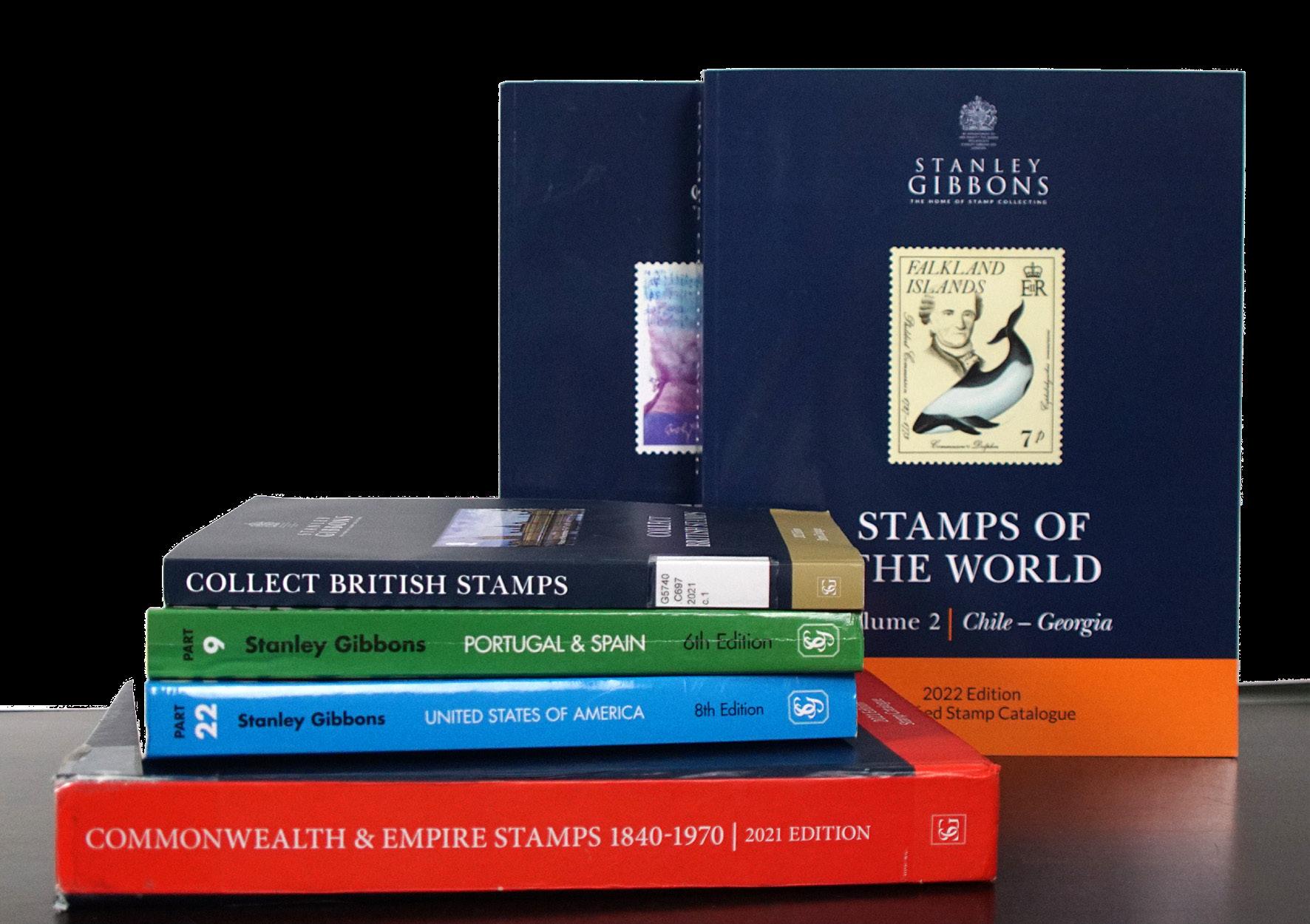
APS and APRL staff, supplemented by Richard West
Stanley Gibbons began as a stamp counter within a family business in 1856 in Plymouth, England. Today, at its West End emporium in The Strand of London, it offers a broad array of retail philatelic stock with more than a million stamps to browse and purchase. In addition to selling philatelic items and supplies it produces one of the world’s finest catalogs, often essential to many collectors, particularly those who collect Great Britain and the Commonwealth.
It is a rarity that about 150 years after stamp collecting and dealing began to evolve that there remains a large company
that has both a catalog and a retail store. The company’s website shows it is currently selling more than 40 catalogs.
Today, Stanley Gibbons group is traded publicly on the London Stock Exchange.
Edward Stanley Gibbons (1840-1913), who was born the same year that Great Britain produced the Penny Black, started the catalog, in 1865 as a teenager. Gibbons worked as an assistant in his father’s pharmacy, where he set up a counter selling stamps.
The catalog – which, of course is actually many individual volumes in many differ-

ent areas – essentially started in November 1865 as a price list. The lists contained prices for used and unused stamps from various colonies and other countries, according to Paul Fraser Collectibles. With it, the famous Gibbons catalog was born. Gibbons himself designed the penny price list, which ran monthly until 1879.

Living in a seaport, Gibbons had no trouble acquiring stock, but being about 200 miles from London, he had trouble selling it, said Hugh Jefferies, a longtime Stanley Gibbons editor in a recent appearance on the “Conversations with Philatelists” podcast (Figure 1). In 1874, Gibbons moved to London. By 1888, the Stanley Gibbons catalog was much larger and included illustrations in the back, Jefferies said.
In 1890, Gibbons sold the company to Charles J. Phillips, who started making major changes to the catalog, including moving the illustrations to be side-by-side with the listings and adding a proper numbering system by country, Jefferies said. Phillips continued to publish a full catalog of stamps of the world, but by the turn of the century was publishing smaller more specific catalogs, such as British Empire, Part 1, which remains its title today. “This was a genius stroke,” Jefferies said in the podcast.
Around World War I, the catalog added “virtual” prices, Jefferies said. These would be values listed for stamps that the company might not have in stock at the

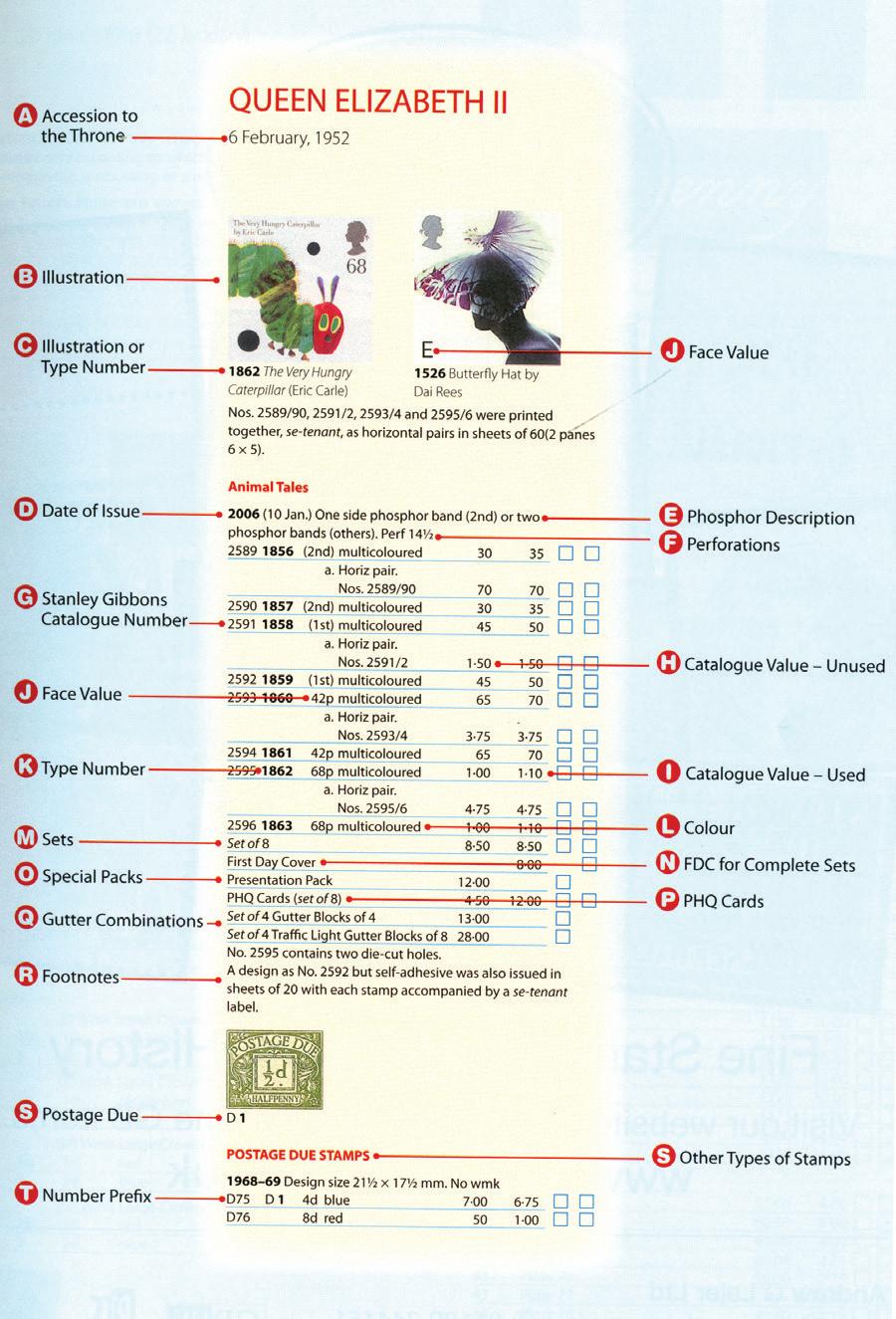
time the catalog (still essentially a price list) was published.
The company continued to create more sectional catalogs, with the 1980s reaching as many as 22 parts. Today, those parts may be further expanded, Jefferies said. Other growth included publishing a Great Britain Specialized in 1980 and the move to full color in 2003.
Jefferies said the company continues to explore specialization and general collection and tries to walk a medium line in regard to its products, but invites consumers to contact them with suggestions.
“We won’t always agree and we’re not promising every suggestion will be taken

up. But please contact us,” Jefferies said.
The strength of Stanley Gibbons is Great Britain and the British Commonwealth. Two essential volumes are updated and issued annually: Collect British Stamps and the Great Britain Concise (Figure 2).
Collect British Stamps illustrates every stamp, including miniature sheets, plus a design index. The listings offer the title and date of each issue (Figure 3). Included are visible plate number differences; watermark differences, essential for collectors of the Dorothy Wilding portrait of Queen Elizabeth II (Figure 4); easily visible chang-

es, such as graphite lines and phosphor bands; adhesive types; and references to printers and printing processes.
Apart from standard definitives and commemoratives (special stamps), there are regional (country), postage due and official stamps, plus prestige books, Frama labels and Post-and-Go labels (Figure 5). These also include a listing of numismatic and medallic covers, and finally a philatelic glossary (Figure 6). Collect British Stamps is subtitled “A Stanley Gibbons checklist of the stamps of Great Britain,” and as such includes boxes for each stamp and variety for collectors to check.
Great Britain Concise is meant for the collector “who wants to take the collection a few steps further.” The listings are similar to Collect British Stamps, but offer more technical details much like a more specialized catalog. These include designers, printers and the processes used, watermark and
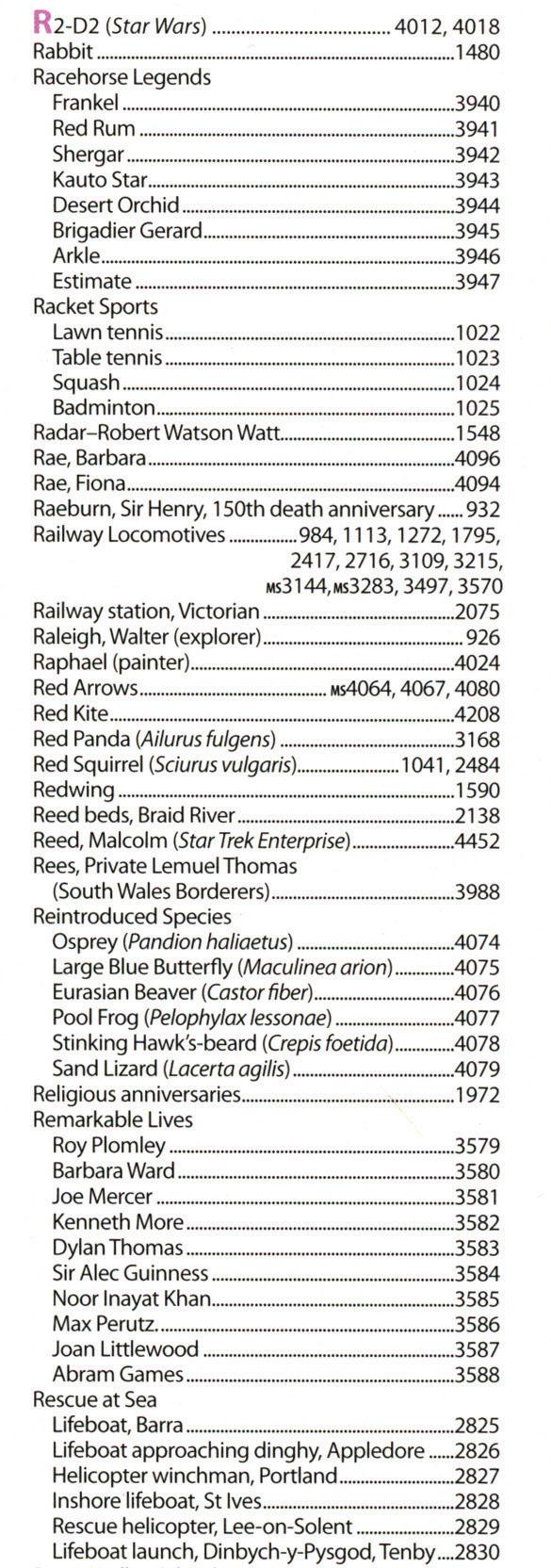
perforation varieties and errors, plus color errors. In addition to prestige booklets, the catalog also includes other stamp booklets, a look at individual booklet panes, Smilers sheets and a more thorough look at Postand-Go issues. This catalog might also be the go-to source for the popular Machins series, which has been ongoing since 1967.
For those who want an extensive study, the five-volume Great Britain Specialized Catalogue could be the way to go. The breakdown: Volume 1 – Queen Victoria; Volume 2 – King Edward VII to King George VI; Volume 3 – Queen Elizabeth II, Pre-Decimal; Volume 4 – Queen Elizabeth

decimal definitives; Volume 5 – Queen Elizabeth II decimal special issues. The listings are so extensive that Volume 4 is already printed in two parts, with similar treatment now under way for Volume 1. Gary Loew reviewed Great Britain Specialized Stamp Catalogue Queen Victoria Volume 1 Part 1 (Figure 7) in the September 2021 issue of The American Philatelist.
The research used to create the technical detail is so vast that it has been more than 10 years since Volume 4 was published and more than 20 years for Volume 5. An example of this research is evident in the 2020 Queen Victoria (Volume 1, Part 1) catalog. This, the 17th edition of the Queen Victoria catalog, came ten years after the 16th edition. And whereas the 16th edition was 356 pages in one single volume, the new edition is 340 pages in Part 1 alone. There are over 180 pages devoted solely to the line-engraved issues.
The annual Commonwealth & British Empire Stamps 1840-1970 (which has re-
placed the venerable old Part 1 for those who go back several years) offers a look at a very popular date range among collectors of Great Britain (Figure 8). Pricing is adjusted appropriately every year. Gary Loew wrote a book review of the 2022 edition of Commonwealth & British Empire Stamps 1840-1970 in the January 2022 issue of The American Philatelist. The 2022 version includes around 175 new varieties from previous editions, including 13 for Rhodesia, built upon research conducted by the Rhodesian Study Circle.
A separate catalog – Collect Channel Islands and Isle of Man Stamps – is created similarly to Great Britain Concise.
Collect British Postmarks has limited availability but is helpful to postal history collectors.
For those going ’round the world with their collecting, the six-volume Stamps of the World fills the bill (Figure 9). Arranged alphabetically by country name, the detailed catalog is still affectionately referred to by its original name, “Simplified.”
While not providing a lot of technical information, the catalog nevertheless provides easy reference to definitive and commemorative stamps, miniature sheets, postage dues and officials (Figure 10). Illustrations are in color, but just one stamp from each set is shown.
For those whose attention is focused on an individual, or possibly a group, of countries, there are about two dozen separate catalogs. Among them are Australia, Canada, Falkland Islands, Hong Kong, India, Ireland, Southern Africa, China, France and Italy.
Also, there are regional catalogs, such as one for Czech Republic and Slovakia and another for Brunei, Malaysia and Singapore.
Not every catalog is published every year. A catalog that has not been issued for

a couple of years is likely to remain available on the company website until a new one is published. One way of knowing the newness of a catalog might be to note the date listed for the latest new issues.
For example, the current Stanley Gibbons website shows the following available: Spain and Colonies, first edition, with new issues of Spain through November 2018; Ireland, seventh edition, with new issues

of Ireland through 2019; and North Caribbean, Bahamas and Bermuda, new issues of Bermuda through 2015. And many more.
Stanley Gibbons also sells a specialized volume written by James Bendon and titled UPU Specimen Stamps 1878-1961 (2015), and created a supplement in 2021. Stanley Gibbons calls this “an essential guide for any philatelist with an interest in the stamps and stationery items distributed to the member countries of the Universal Postal Union.”
Although a collector can choose to cut off at any year, a catalog publisher cannot do that. “We have to acquire all of these stamps in order to study them carefully,” Jefferies said. “Every stamp issued needs to be inspected in order to produce an accurate listing, with face value, description, colors, print methods, (hopefully) designer, the actual ‘what is depicted,’ the perforation, the watermark if there is one. Every aspect needs to be carefully checked and annotated in the catalog.”
Jefferies noted that catalog editors have a
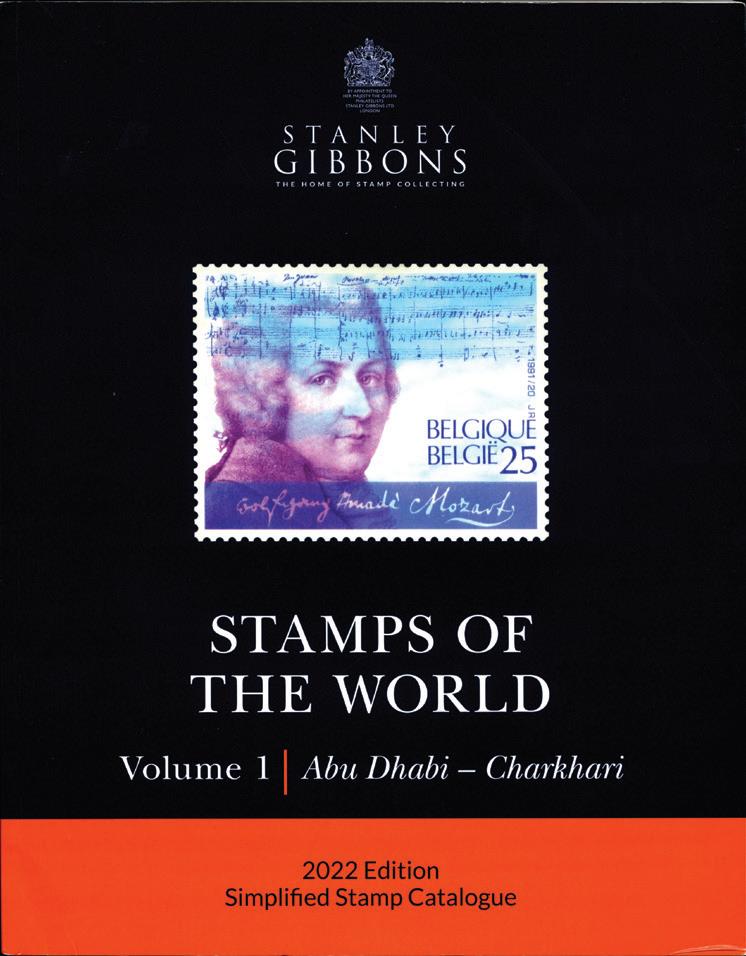
couple of battles. One of these is inaccuracies about stamps from certain postal services and postal services that sell two types of stamps, one for the mail-using public and another for collectors. Details of the former type are not always shared with catalogs out of fear that collectors will snatch them up and mail-use postage won’t be available for the public, Jefferies said. In this case, it may be some time – maybe even years – before the stamps are noted in a catalog.
“There is a limit on what we can do,” Jefferies said about updating information such as discoveries or earliest known uses. Catalog editors count on societies, dealers, auction catalogs and individuals to provide them with up-to-date information that could prompt adjustments in the catalog.
“Yes, [pricing is] a possible slightly contentious area,” admits Jefferies, who re-
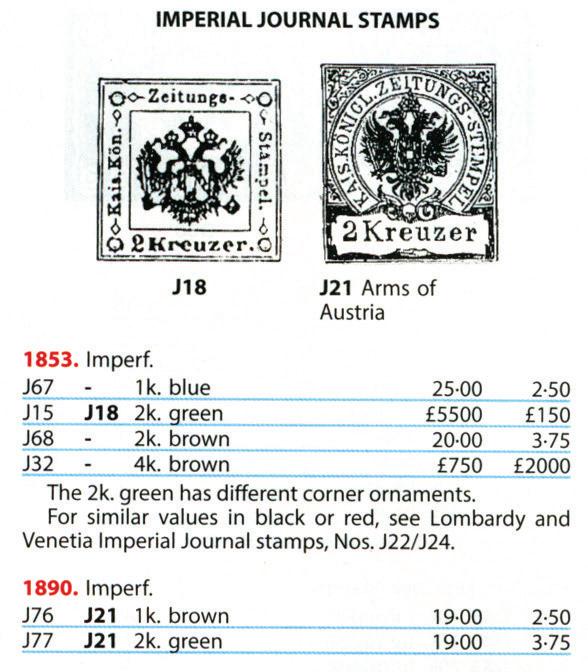
minds consumers that, as it was from the start, the Stanley Gibbons catalogs serve as the company’s price list. It’s important that prices in catalog – which is the amount you would pay for an item at Stanley Gibbons retail – are as accurate as possible. Each catalog receives price checks and adjustments for all stamps before it is published.
About two dozen catalogs – including most Great Britain, plus China, Germany, Switzerland and the Middle East – have been created in digital form. Several have been offered via an app for several years. All are searchable.
“Hopefully, in the not too distant future you will be able to pick and choose exactly those parts of the catalog you are looking for,” Jefferies said.
For more information, visit Stanley Gibbons online at: www.stanleygibbons.com.

One of the American Philatelic Society’s many strengths is its affiliates, the members of whom are on the forefront of research in their areas and active contributors to the deep well of philatelic knowledge. Many of these specialty societies devote much time and energy to revising and adding to the record of that which has been discovered in their area. In 2021, the APS editorial team reached out to its affiliates to learn about their publications, specifically catalogs, that are available for collectors. These catalogs are often the summation of the society members’ gathered knowledge over decades.
The following catalog listings were provided by many participating affiliates, regardless of the type of philatelic material involved, and include everything from postal stationery to plate numbers to revenues to postage stamps. Some of these catalogs have already been reviewed in The American Philatelist or the PLR. While not all affiliates were able to participate, this sampling is a demonstration of the hard work devoted to maintaining and increasing philatelic knowledge.
Hebert's Reference Guide of Plate Number Singles. 2018 edition currently available. Edited by Rick Burdsall. 750-plus pages, 8½ by 11 inches. Published by APNSS and Rick Burdsall, July 2017. Available from www.apnss.org, eBay, and U.S. Specialist.
Hebert’s catalog lists and prices mint and used plate number singles from 1890 to 2017 issues. This includes regular issues and commemoratives, coils, booklets, modern die-cut-omitted issues, airmails, special delivery, parcel post, duck stamps, expanded backof-the-book issues such as postage due, postal savings, war savings, modern officials, and offices in China. Specialists will appreciate the listings of siderographers’ initials, plate finishers’ initials, hand-entered offset plate numbers, ZIP, Mail Early, copyright, pane position diagrams (PPD), 5-point / 6-point stars, C / CS / EI markings on flat plate issues, and more. The catalog includes PNS for Allied Military Government / AMG issues for France, Italy, Germany and Austria, and overprinted U.S. issues for Canal Zone, Guam, Puerto Rico, and Philippines. The catalog is intended to serve as a reference, catalog, and checklist.

China Stamp Society Specialized Catalog of China to 1949. 2021 edition. Edited by H. James Maxwell. 506 pages with 1,000+ illustrations, 9 by 9 inches. Published in March 2021. ISBN: 9780615550336. Available from www.chinastampsociety.org/, Amazon, and by mail to H. James Maxwell, China Stamp Society, PO BOX 481844, Kansas City, MO 64148-1844 U.S.A.
This full color listing begins with the Imperial issues of 1878 through the Republic issues of 1949, including a comprehensive listing of varieties and previously unlisted stamps. The catalog also includes rate tables, a glossary of terms and Chinese characters, an overprint and surcharge guide and a bibliography of other useful resources.
This catalog was reviewed by Archie McKee on page 68 of the January 2022 The American Philatelist.

A Handbook of the Stamps of Cuba (1855-1961). Third edition. By William McP. Jones and Rudy J. Roy. 350 pages and thousands of illustrations, 7 by 9 inches. Published in 2019. Available from Cuban Philatelic Society (CPSA) P.O.Box 141656, Coral Gables, FL 33114,or email: cpsatreasurer@ gmail.com.
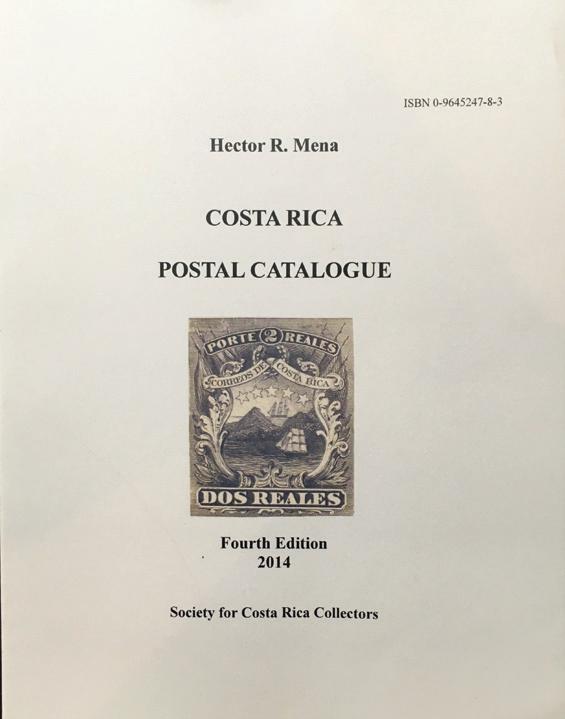
The third edition was born from the work of the late William McP. Jones on the essential first edition and expanded upon by Rudy Roy and members of the Cuban Philatelic Society of America. It has three major sections: Spanish Cuba 1855-1898; The United States Administration 1898-1902; and The Republic 1902-1961. The handbook also includes specialized areas such as varieties, proofs, specimens, errors and more. More information is available from http://www. cubapsa.com/publications.
This catalog was reviewed by Nick Salter on page 64 of the January 2022 The American Philatelist.
Winnegrad’s Printing on Stamps. Fourth edition. By Bruce L. Johnson. 120 pages, no illustrations, 8½ by 11 inches. Published in April 2017 (annual supplements available). Available from Larry Rosenblum, Secretary, 773 E El Camino Real #175, Sunnyvale CA 94087-2919, larry_gpa@larryr.com.

Winnegrad’s Printing on Stamps is a comprehensive list of stamps relating to any form of graphic (visual) communication, from cave paintings to QR codes. There is an emphasis on writing and printing, including the process of creation (e.g., printing equipment and technology, alphabets) and the end result (e.g., books, journals). The list is organized by topic, then country within each topic. Scott numbers are included, but items are not priced. More information is available at https:// www.graphics-stamps.org/publications.html.
Annual supplements are published each summer and are available for members and non-members. The association can also be found on Facebook at https://www.facebook.com/ groups/graphicsphilately
International Postage Meter Stamp Catalog / United States Postage Meter Stamp Catalog. By Richard Stambaugh. Digital edition, published through Wikibooks in 2015.

The Meter Stamp Society sponsors two online meter postage stamp catalogs that cover postage meter stamps used in every country that used postage meter stamps. For those not familiar with Wikibooks, it is a collaborative book authoring website from the same team that created Wikipedia. The International Postage Meter Stamp Catalog includes a table of contents linking to different sections (such as an identifier, glossary and bibliography) and a listing of countries. There is also a listing of the recent changes made to the catalog by its contributors. It can be read at https://en.wikibooks.org/wiki/International_Postage_Meter_Stamp_Catalog.
Similarly, the United States Postage Meter Stamp Catalog on Wikibooks shows recent changes, shares introductory material on what readers should know about meter stamp collecting in the U.S., and gives specific links to types of meters (organized into “Groups”). It can be found at https://en.wikibooks.org/wiki/United_States_Postage_Meter_Stamp_Catalog.
Nicaragua to 1940: A Philatelic Handbook. Second edition. Edited, revised, and enlarged by Michael Schreiber and William Blampied. 280 pages, more than 800 illustrations, 8½ by 11 inches, digital PDF format. Published October 2020. Available free with membership to Nicaragua Study Group, contact Michael Schreiber at momotombo@woh. rr.com.
The first edition of Nicaragua to 1940 was published by Clyde Maxwell in 1992. This second, digital edition was updated in 2020 and is available upon contact with co-author Schreiber.
This catalog was reviewed by Nick Salter on page 61 of the January 2022 The American Philatelist.

Catalogue of Stamps of the Federated States of Micronesia. First edition. By Terry Commins. 75 pages, numerous illustrations, A4 pages. Published in 2020. Free to members, www.pisc.org.uk. Contact PISC, 24 Woodvale Avenue, London SE25 4AE, UK, or secretary@pisc.org.uk.
The Pacific Islands Study Circle published in 2020 a catalog of the stamps of the Federated States of Micronesia up to 1990. The catalog contains a number of features not normally found in regular catalogs, including the examination of individual islands/population centers, and provides some of the historical context that is usually of interest to philatelists. The ultimate goal is to create interest in a little collected area. The catalog is available in the members’ area of the website, www.pisc.org.uk, for free download to members only.
MEMBER FAVORITESI use the Stampless Cover Catalog on a weekly basis and find it invaluable. Specifically, I collect free frank covers and the listings of who had franking authority in Volume II, coupled with the markings in Volume I help me identify and date the covers. I understand the USPCS is in the process of updating the catalog and it would be good to read about the progress they are making. -Phil Candreva
Postal Markings on Stampless Mail from Warren County, Pennsylvania. Compiled by Robert C. Leberman and Thomas C. Mazza. Available from http:// paphs.org/paphs-publications.
Postal Markings on Stampless Mail from Erie County, Pennsylvania. Compiled by Thomas C. Mazza. Available from http://paphs.org/paphs-publications.
Postal Markings on Stampless Mail from Lebanon County, Pennsylvania.
Compiled by Glenn L. Blauch, Richard A. Colberg and Thomas C. Mazza. Available from http://paphs.org/paphspublications.
Postal Markings on Stampless Mail from Lancaster County, Pennsylvania.
Compiled by James G. Boyles, Richard A. Colberg and Thomas C. Mazza. Available from http://paphs.org/paphspublications.
The Pennsylvania Postal History Society has published four monographs on stampless mail in various Pennsylvania counties. Using Lancaster County as an example, the catalog is organized by post office and for each shows the various townmarks, auxiliary and rating marks that are known for each post office, including dates of use (as known) and a rarity factor. A list of postmasters and their appointments is included where known. The monographs were created with the intention that collectors could report new information and findings, supply copies of missing markings, and more.


Pitcairn Islands Postal History and Stamps 17902015 . First edition. By Vernon N. Kisling, Jr. 150 pages and many illustrations (all stamps 1940-1990 in color), 8½ by 11 inches, softbound. Published in 2018. Available in print and PDF versions from Moosehead Communications, 207 Corinth Road, Hudson ME 04449-3057.
The postal history aspect of this catalog refers to islander communication and the post office history. There are a few pages devoted to Pitcairn history from 1790, including New Zealand’s postal concession and the Pitcairn Islands Post Office from 1940 on. Most of the catalog is devoted to a specialized stamp listing, shown in color illustrations, beginning with Pitcairn Islands’ first issues in 1940 up through 2015. No information on values is provided.

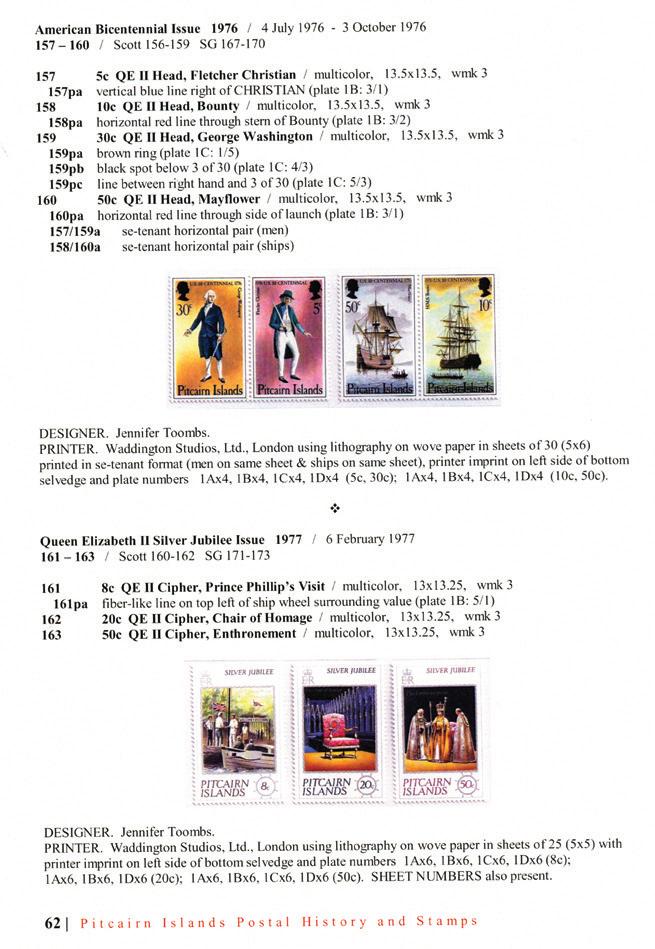
Encyclopaedia of Rhodesian and Zimbabwean Postage Stamps Since 1964. Updated in January 2022. Compiled by many contributors. 2,200 pages, A4, in digital PDF form. Available for free download at http://www.rhodesianstudycircle.org.uk/encyclopedia-of-rhodesian-and-zimbabwean-postagestamps-since-1964/.
A concept that began as an update to the Mashonaland Guide to Rhodesia’s Postage Stamps eventually became the Encyclopaedia of Rhodesian and Zimbabwean Postage Stamps Since 1964, produced by the Rhodesian Study Circle. The online-only catalog is consistently updated as new information is discovered, with the most recent update as of this writing occurring in January 2022 – the Rhodesia 1965-1979, Zimbabwe 1980-1999, and Zimbabwe 20002021 sections. The Rhodesian Study Circle welcomes feedback and additional material to supplement the contents of the online catalog.
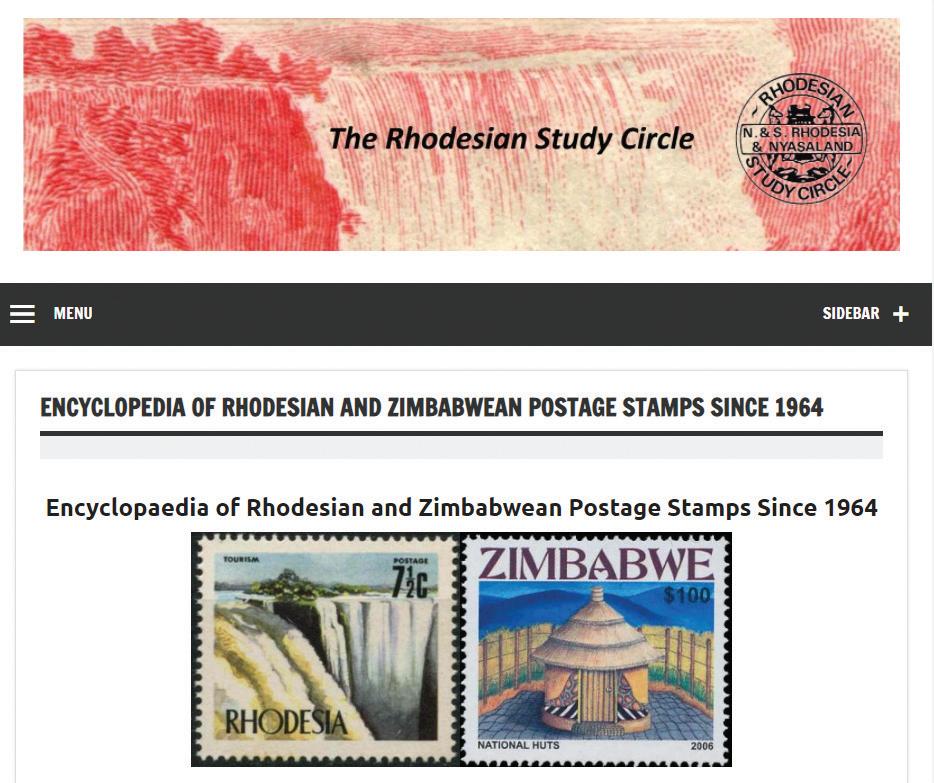
Worldwide Scouting on Stamps. Revised edition, December 2014. By Dennis C. Shields. 885 pages, approximately 5,000 illustrations, 8½ by 11 inches, electronic PDF format. Published in 2014. Updates available at www.sossi.org. Available from sossi.org/society/join.htm or contact SOSSI C/O Peter E. Metzloff, 468 Halifax Ln., Medina, OH 44256, pmetzloff@gmail.com.
Worldwide Scouting on Stamps is the most complete listing of Scouting issues known and an update to the late Paul Toneman’s Scouts on Stamps, A Checklist handbook. The handbook lists known legitimate issues related to Scouts and does not include cinderellas or error varieties. A portion of this catalog can be viewed at no cost at https:// sossi.org/catalog/shields.htm


Costa Rica Postal Catalogue. 4th digital edition. Edited by Hector R. Mena. In CD (digital) format. 315 PDF pages and over 1,500 (mostly) color illustrations. Published in 2018. ISBN: 0-9645247-8-3. Available from www.socorico.org.
The Costa Rica Postal Catalogue fourth edition is available as a digital version as of 2018, updating the print fourth edition published in 2014. Print copies have black and white illustrations, while the digital version has color illustrations.
This catalog was reviewed by Nick Salter on page 59 of the January 2022 The American Philatelist. Also available:
Mena-Rohrmoser Costa Rica Documentary Revenue Stamp Catalogue. Digital version of the Second Edition 2006 . Edited by Hector Mena, Rafael Pinto and Fernan Pacheco. In CD (digital format). Color illustrations.
Catalogue of Puerto Rico Revenues – U. S. Administration, Sept. 1898 – Present. First edition. By Gregg Greenwald. 196 pages, 1,250 illustrations, 8½ by 11 inches. Published by author, May 2021. ISBN 978-0-578-82515-1. Available from Greenwald at bluebird@tznet.com or Amazon.

In finding that the Chabot catalog including Puerto Rico revenues was not complete, the author began to create a new catalog. The result, Catalogue of Puerto Rico Revenues, is organized into documentary, tobacco, alcohol, miscellaneous, association/trade, municipals and essays/proofs/specimens. While far from a complete listing, this is the most comprehensive list of Puerto Rico revenues. The author invites collectors to contact him with updates, confirm questions, and share additional information to fill in the incomplete sections, which will result in further editions. Further purchasing information and options are available at https:// uspps.tripod.com/id18.html.
Reviewed by Alan Warren on page 231 of the third quarter 2021 PLR.
The United States Postal Stationery Society is a prolific publisher of U.S. and worldwide postal stationery catalogs. The listings below are just a few of those available in print –some can also be found as PDF publications.
United States Postal Card Catalog. 75th anniversary edition. By Lewis Bussey. 284 pages, 8½ by 11 inches. Published in 2020. ISBN: 978-1-7327880-7-7; 978-1-7327880-8-4 (eBook). Available from UPSS.org.
United States Stamped Envelopes Essays and Proofs. Second edition. By Dan Undersander. 376 pages, 8½ by 11 inches. Published in 2019. ISBN: 978-17327880-1-5; 978-1-7327880-2-2 (eBook). Available from UPSS.org.
Reviewed by Alan Warren on page 147 of the second quarter 2020 PLR.
U. S. Precanceled Postal Cards 1874 – 1961. First edition. By Josh Furman. 30 pages, 8½ by 11 inches. Published in 2020. ISBN: 978-1-7351629-1-1. Available from UPSS.org.
Reviewed by Alan Warren on page 154 of the third quarter 2021 PLR.
Postal Stationery of Mexico. First edition. By Peter Bamert, Wayne Menuz, and Bill Walton. 415 pages, 8½ by 11 inches. Published in 2017. ISBN: 978-09970744-5-1. Available from UPSS.org.
The Western Express Companies 1850-1890. Third edition. By Oscar Thomas. 1098 pages, 8½ by 11 inches. Published in 2020. ISBN: 978-1-7327880-5-3; 978-1-7327880-6-0 (eBook). Available from UPSS.org.
Reviewed by Alan Warren on page 62 of this issue.
U.S. 19th Century Stamped Envelopes, Lettersheets and Wrappers of the United States. Fourth edition. By Dan Undersander. 260 pages, 8½ by 11 inches. Published in 2018. ISBN: 978-1-7327880-0-8. Available from UPSS.org.
Reviewed by Alan Warren on page 70 of the first quarter 2020 PLR.
U.S. 20th and 21st Century Stamped Envelopes and Wrappers of the United States. Fourth edition. By Dan Undersander. 427 pages, 8½ by 11 inches. Published in 2017. ISBN: 978-0-9970744-6-8; 978-0-9970744-9-9 (eBook). Available from UPSS.org.
Postal Stationery of the Canal Zone. Third edition. By Irwin Gibbs. 63 pages, 8½ by 11 inches. Published in 2014. ISBN: 978-0-9886075-3-8. Available from UPSS.org.
Historical Catalog of U.S. Postal Card Essays and Proofs. Eighth edition. By Bill Falberg. 491 pages, 8½ by 11 inches. Published in 2018. ISBN: 978-09970744-8-2. Available from UPSS.org.
Reviewed by Alan Warren on page 149 of the second quarter 2020 PLR.
Durland Standard Plate Number Catalog. Compiled by Kim Johnson. 437 pages, 8½ by 11 inches, spiral and perfect bound. Published in 2020. Available from the APS Publications shop.
The Durland catalog is a comprehensive listing of plate and value information for United States postage and revenue stamps, useful for the specialized collector. New editions are published every three or four years, in expanded, full-color formats.

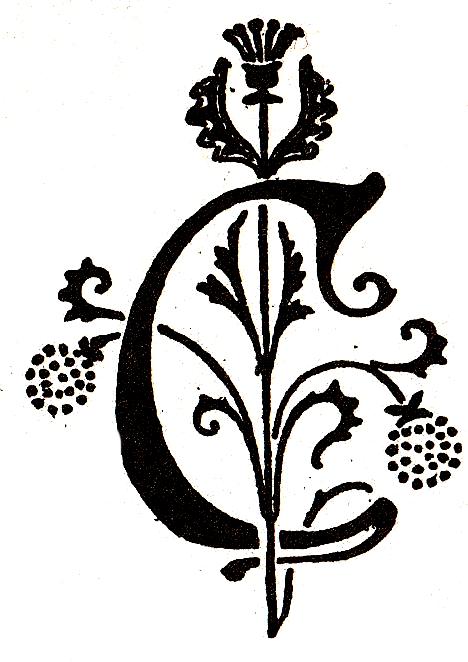
he last worldwide catalog of revenue stamps was created by A. Forbin and published by Yvert & Tellier in 1915. Subsequent to World War I, most single country catalogs dropped the inclusion of revenues as the number of postage stamps had grown to the point that they filled what was thought to be the practical limit of a stamp catalog. The notable exception to this was the United States, where Scott Publications continued to include U.S. revenue stamps in their catalogs.
The late Gary Ryan, of the United Kingdom, in his acceptance talk for the 1998 Lichtenstein Award, credited the omission of revenues in foreign country stamp catalogs as the reason why most foreign stamp dealers did not include revenues in their inventories, why collectors of these foreign country revenues almost didn’t exist, and why information about these foreign revenues was rarely encountered in the philatelic world.
Martin Erler, of Germany, was a prolific publisher of the revenues in the German area. Erler’s catalogs, which started in the mid-1970s, spawned a renewal of interest in collecting the revenues of all countries
"The omission of revenues in foreign country stamp catalogs [is] the reason why most foreign stamp dealers did not include revenues in their inventories, why collectors of these foreign country revenues almost didn’t exist, and why information about these foreign revenues was rarely encountered in the philatelic world.
and for others to produce catalogs for their respective countries. The efforts of Ryan, Martin Erler, Björn-Eric Saarinen, of Finland, and Robert Cunliffe, of the U.S., led to the creation of the FIP Revenue Commission at an exhibition in 1996 in Istanbul.
Through all of this renewal of the interest in the revenues of foreign countries, the foundation for the listings of the early issues was the comprehensive listings of the 1915 Forbin Catalog. A reprint edition was produced by Duane Zinkel, who advertised its availability in The American Revenuer (the journal of the American Revenue As-

sociation) in the mid to late 1970s and it is this reprint that many of us have in our libraries today (Figure 1).
To give some sense of the comprehensiveness of the Forbin listings, let’s take a look at some of the listings of United States revenues and compare these listings to the current standard, the Scott United States Specialized Catalogue. The Forbin listings cover 48 pages and include some categories that remain unlisted in the Scott catalog!
The Forbin listings of the United States are organized in a number of large sections:
Consular (Scott RK prefix)
Documentary
1. Up to 1898 (Scott R1 - R152, excluding the proprietary and playing card stamps of the First Issue)
2. Playing Cards (First Issue and Scott RF prefix)
3. Proprietary (First Issue and Scott RB prefix)
4. 1898 and after (Scott R153R194)
5. New York stock transfer (not listed in Scott)
Private Stamps
1. Match (Scott RO prefix)
2. Canned Fruit (Scott RP prefix)
3. Medicine (Scott RS prefix)
4. Perfumery (Scott RT prefix)
5. Playing cards (Scott RU prefix)
6. Medicine (Scott RS278 - 306) There is a footnote to this section that pictures one of the private issues known today as Sanitary Fair stamps.
General Imposts1
1. Beer (Scott REA prefix)
2. Tobacco (not listed in Scott)
a. Cigarettes
b. Imported cigarettes
c. Cigars
d. Snuff
e. Manufactured Tobacco
3. Custom House (Scott RL prefix)
Stamps of the States (not listed in Scott)
1. Alabama
2. California
3. Louisiana
4. Nevada
5. Oregon
Colonies of the United States
1. Philippines (not listed in Scott)
2. Puerto Rico (Scott R prefix)
The Forbin listings of United States revenues are a remarkable accomplishment for a catalog compiled and published in a European country.
One of the interesting parts of the Forbin listings is the taking of the Proprietary and Playing Card titles and placing them in a separate category along with the later proprietary and playing card stamps (Figure 2). The Scott catalog has never done this.
An examination of the law that brought about these stamps has a Schedule A for documentary taxes and a Schedule B for proprietary goods (matches, medicines, canned goods, photographs, perfumes and playing cards). Forbin seems to recognize this from the outset of the Civil War era taxes, whereas the Scott catalog only begins this distinction in 1872 for the general proprietary category and in 1894 for the general playing card category. In fact, the so-called First Issue revenue stamps with Proprietary and Playing Card titles were never supposed to be used on documents. What a wonderful insight of Forbin to segregate these titles and enjoin them with their later counterparts. One might wish Amos Publications, publisher of the Scott catalogs, would be so insightful.
Among the revenue stamps listed in Forbin that remain unlisted in the Scott catalog are the tobacco taxpaids (Figure 3). It should be noted that a 1912 publication authored by Bartlett and Norton, popularly

Figure 2.
known as the Springfield List, has a far more detailed listing of the tobacco taxpaids than the Forbin listings. In fact, the taxpaid categories in the Bartlett and Norton work are far more extensive than Forbin with the addition of distilled spirits, oleomargarine, process butter, filled cheese, mixed flour, hydrometer labels and lock seals, to name a few of the categories included. But then, the authors of the Springfield List were enthusiastic stamp collectors who resided in the United States.
Forbin’s recognition of the early revenues of Alabama, California, Louisiana,
Nevada, New York and Oregon is also extraordinary. Again, none of these is given any recognition in the Scott catalog. It should be noted that the California stamps (i.e., paper “stamps”) even precede the first federal paper revenue stamps of the Civil War era (Scott R1-150).
One also might note that the Sanitary Fair stamps mentioned in a footnote of the Forbin listings are not recognized by U.S. collectors as revenue stamps. They paid the fee of transporting letters from the fair to a U.S. post office and the mail stream through which they were delivered to their

destination. They are currently listed in the Scott catalog after the Christmas seals and are described as occupying “a position midway between United States semi-official carrier stamps and the private local posts.” Curiously, the physical location of these Sanitary Fair listings in the catalog is neither midway between nor even close to the carriers and locals listings.
Although this early Forbin catalog may not be the ready reference for today’s collectors of worldwide revenues, it deserves a place on our library bookshelves. An occasional perusal of its listings (e.g, its insights
as noted above for U.S. revenues) is recommended for all revenue stamp collectors.
Endnote
1. “Imposts” is the name used by Forbin and has often been used in British publications. It is synonymous with taxes.
Bartlett & Norton. United States Internal Revenues Stamps, Hydrometers, Lock Seals (1912). (Also known as “The Springfield List”)
Forbin, A. Catalogue de Timbres Fiscaux (Paris: Yvert & Tellier, 1915).
Kantor, A. R, & M. S. Kantor. “Sanitary Fairs, A Philatelic and Historical study of Civil War Benevolences” (Amos Press, 1992).
ATone point in our lives, we ask ourselves, paraphrasing Paul Gauguin, “Where Do We Come From? What Are We? Where Are We Going?” The famous allegorical postimpressionist painting created by French artist Paul Gauguin in Tahiti is displayed in the Boston Museum of Fine Arts. Indeed, during my 18-year tenure as a physicianscientist at Harvard Medical School, I was fortunate to enjoy and be inspired countless times by Gauguin and other Boston MFA masterpieces.
My professional background as an organ transplant researcher, blended with compassion for fine arts and a collector’s zeal, was instrumental in creating a nurturing environment for my later postal history research and writings. These culminated in a recent publication of a two-pound hardbound volume, The History of Airmail in Poland and Its Contribution to Airmail Services of Europe (1914-1939) (Figure 1). The venture, supported by the Collectors Club of Chicago, has already proven quite successful, as evidenced by the John Kevin Doyle Grand Award and large gold medal at Chicagopex-2021, glowing reviews at both sides of the Atlantic, and growing sales, which obvi-
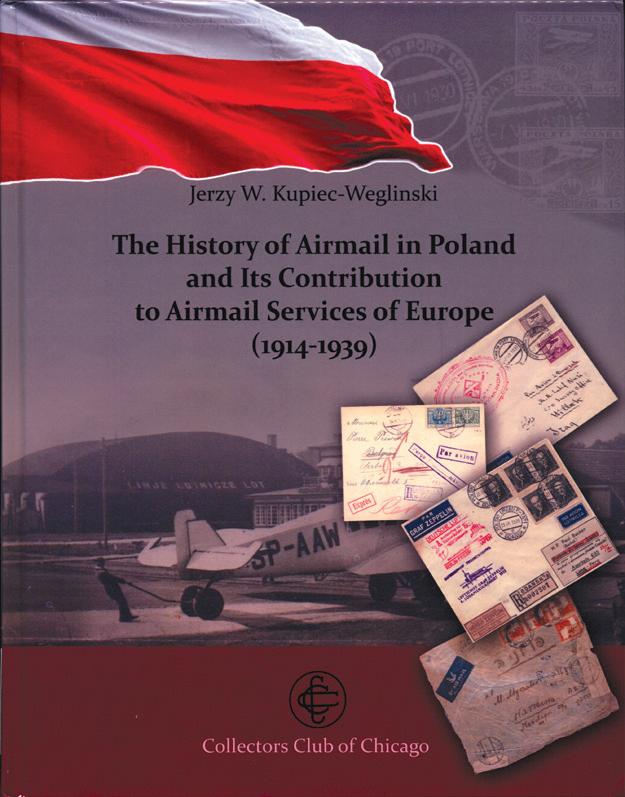
ously make the publisher happy.
So, how did the concept for the book come about? The road was long and somewhat crooked at times.
My earliest recollections of postal history inclinations come from my early teenage years when my grandma received mail in Warsaw from her friend in Lvov, now a part of Soviet Union. Grandma left her native Lvov, then a Polish city, during the Second
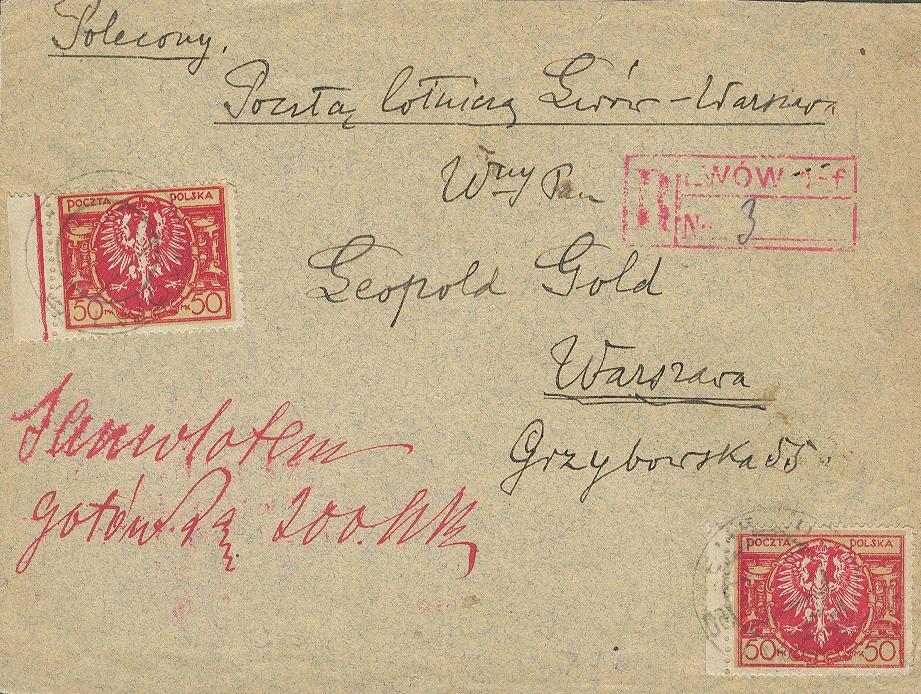
World War, and I remember how she was awaiting mail to arrive in her new home. I was fascinated by colorful Russian stamps and even more by numerous markings on envelopes, which, as I found out later, were of both postal and communist censorship origins.
I also recall visiting “Polska-60,” the FIP-sponsored international philatelic exhibition celebrating 100 years of the first Polish stamp. It was fall 1960, I was 9 years old, and the director of the Warsaw show was Zbigniew Mikulski, the future worldfamous philatelic expert and exhibitor. It was Mikulski who 52 years later sent a congratulatory note on my postal history study, “Airmail of the Siege of Przemysl 19141915.” The piece received the U.S. Stamp Society Barbara Mueller Award for the best article published in 2012 in The American Philatelist
As a Warsaw high school student, not knowing I would spend most of my adult life in the United States, I attended the highly esteemed Methodist English Lan-
guage School. It was there that I often witnessed an older gentleman in an adjacent storefront window, sitting behind a massive mahogany desk and trying to sell electric appliances as well as “stamps from all over the world.” Only years later, I realized the man I was regularly seeing via a storefront window for over two years was Tadeusz Gryzewski. He is now recognized as the godfather of Polish aerophilately and a driving force behind so many first flown covers from the 1920s and 1930s that I proudly present in my collection and review in my book.
After obtaining my M.D. and Ph.D. in Warsaw, I left Poland in 1979 for a post-doc fellowship at Harvard Medical School. Soon after, the Solidarity upheaval and martial law imposed in the country changed everything, including my life. Unable to return to my homeland, in 1986, I accepted an invitation to spend a year sabbatical at Oxford University, a European organ transplant mecca – the focus of my life-long scientific career. Many weekends during that year
were spent in London, enjoying museums, art galleries, and, of course, the Strand Stamp Centre. It was where I met Zbigniew Bokiewicz, who traded stamps in Germanoccupied Warsaw in 1939, was captured as a Boy Scout during the Warsaw Uprising in 1944, and from the Murnau P.O.W. camp, escaped to Great Britain. Here, he traded again in one of the Strand arcades, Continental Stamp Supplies, Ltd., opposite the famous Stanley Gibbons. After purchasing from Bokiewicz two airmail covers from Warsaw — Lvov flights in 1922 (at £4.50 each; Figure 2)— my future Polish airmail collection, now with two large gold FIP medals, was conceived. The airmail collection represents the book’s core, covering more than 400 pages and 700 illustrations.
Airmail collectors are likely familiar with the Nierinck crash cover catalog, Recovered Mail, published as two volumes in 1992 and 1995. This mainstay reference for recovered mail refers to a crash that is very personal to me, about LOT Polish Airlines “Kopernik” on March 14, 1980: “After a
flight from New York and Montreal to Warsaw, the pilot lost control and crashed near Warsaw airport. All occupants lost their lives. Mail is known.”
On a personal note, among 87 people on board was Grazyna Szafarkiewicz-Weglinska, a LOT flight attendant and my wife. I dedicated a chapter on crash mail in my book to Grazyna and all who perished in LOT disasters before and after the crash of March 14, 1980 (Nierinck 800314, where 80 stands for 1980, 03 is March, and 14 represents the day). I cannot state unequivocally whether this tragedy influenced, perhaps subconsciously, my future aerophilately collecting and research. However, it became apparent to me that every postal item has a unique, albeit sometimes a tragic story to tell. Each piece of mail with a variety of stamps and postal markings represents a “Gauguinian” small art-form with its origin (i.e., where does it come from?) and destination (i.e., where does it arrive to?).
The 12 chapters in The History of Airmail in Poland present and discuss postal docu-
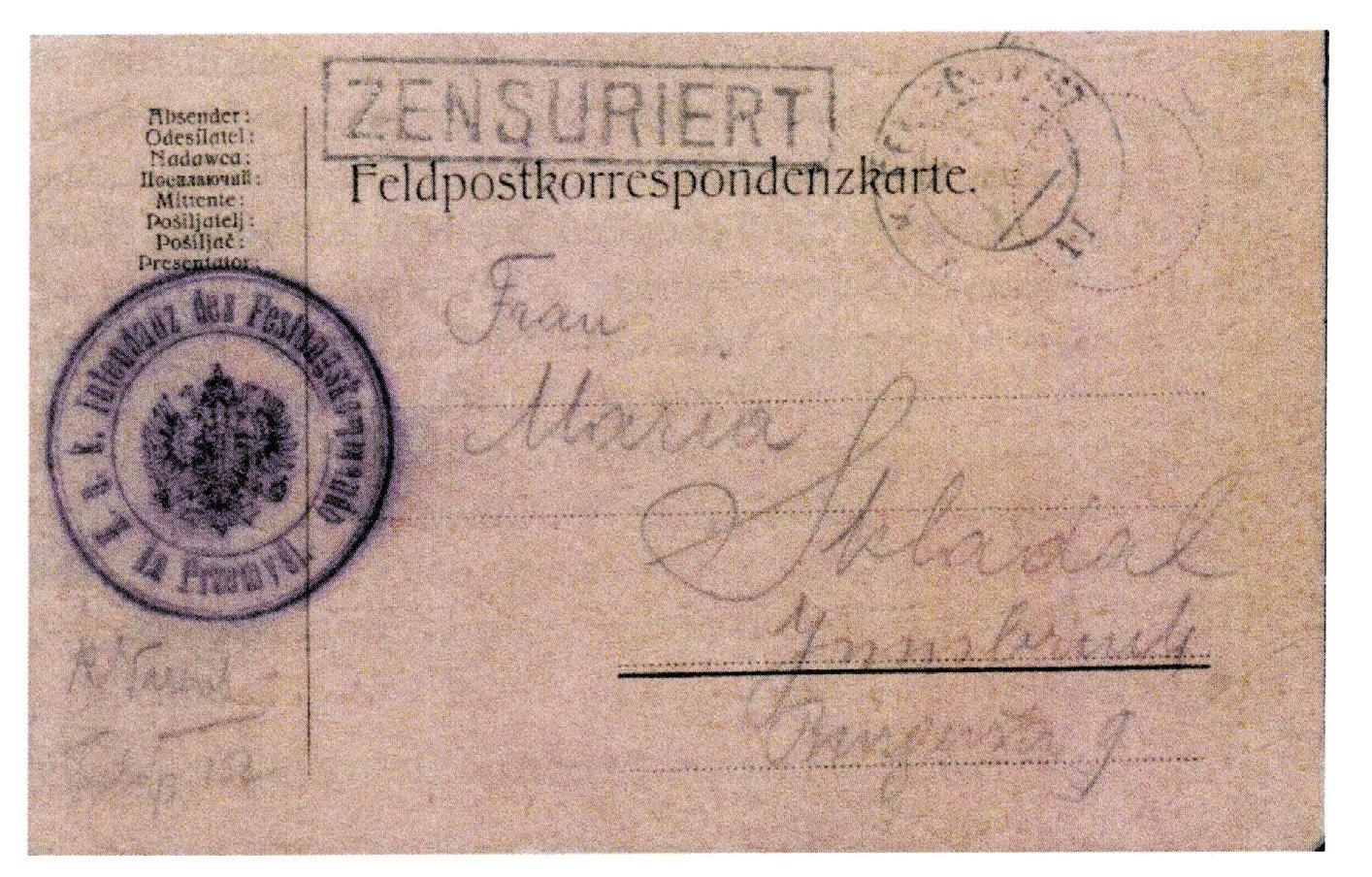
ments, encompassing, in chronological order, all major civilian airmail theaters and aviation ventures recognized by the Polish postal administration throughout 25 years of turbulent European history in the 20th century. Indeed, many covers introduced in the book are more than just covers because they became silent observers to history. It starts with the events during World War I from October 1914 to March 1915, in a remote part of the former Austro-Hungarian province, the Galician town Przemysl. It concludes with the invasion of Poland by Nazi Germany in September 1939 and the outbreak of World War II. I did not cover military or pigeon mail and privately sponsored balloon-flown postal events in more detail.
The book tells an intriguing story of the technical success of the commercial aviation sector, which linked the country with often faraway places, but was cut short by global politics and military conflict.
One of the noteworthy episodes in airpost history was the competition between major European air carriers to explore new passenger, mail and freight services routes and to dominate the far reaches of their colonial empires. I intended to tell the story of Polish airmails in the forerunner, pioneer and expansion periods of the global aviation “revolution.” I present their richness and diversity, discuss routes, postage rates, postmarks, cachets, and, of course, introduce the people behind it all. As an aero postal history student, I look back and marvel at the records of achievements, capturing some of the excitement and “romance” of early aviation by presenting postal documents and the stories behind uncharted air travels some 90 years ago. For instance, the pilot roster of the French Aéropostale company included such aviation legends as Jean Mermoz and Antoine de Saint-Exupéry, a writer, poet, journalist
and a pioneering aviator.
Many years passed before the idea of publishing this book, based on my own collections and in-depth research, came to fruition. From a postal history perspective, this was not an easy task as the original documents are either sparse or nonexistent due to the calamities Poland has experienced in the past. An obvious hardship was finding philatelic sources of the events in this part of Europe, compiling data, and ultimately writing it all up coherently and excitingly for the reader who is not necessarily a postal history student, all while residing in California.
I am glad and most grateful to everyone who provided me with the information, scans of their treasures, and encouraged me not to quit even after my computer crashed and I had to painstakingly recreate the content. Yes, this was a long and sometimes traumatic journey. I am certainly glad it did not end up like that of Nicolaus Copernicus, the famous astronomer and my compatriot, who was presented with a printed version of his life’s work, De revolutionibus orbium coelestium, while on his death bed in May 1543.
The major problem in researching early Polish airmails, however, was my very limited access to original postal documentations and the lack of comparative material for rare philatelic items. Two events were instrumental in expanding my aerophilately horizons.
First, in December 2002, while in Warsaw to accept the doctor honoris causa degree bestowed on me by my alma mater (after being banned from the country for almost 10 years due to political reasons), I met Jacek Kosmala. He is a preeminent Polish philatelist and international judge and has won several gold FIP medals for his Polish airmail exhibit. Despite a friendly competition in the same collecting postal
history area, we joined forces by researching Polish aerophilately while on different continents for almost two decades. Writing this book would have been impossible without Jacek’s help.
Second, in summer 2004, I met Dr. James Mazepa of Sarasota, Florida, in Los Angeles. He has become a dear friend and a philatelic mentor since then. James was the first recipient of a FIP gold medal at a world exhibition for his Polish airmails. A black and white copy of his collection, sold at the Manning auction in 1989, became my aerophilatelic roadmap and “bible.” Jim’s enthusiasm and perseverance in researching various facets of the Polish aerial postal history have been most inspirational, and I owe him my highest gratitude.
The year 2004 also marked my first national philatelic exhibition, ARIPEX, in Phoenix, Arizona, where I received a vermeil. When I asked the judge how to improve to gold, he answered, “Expand into zeppelin mail.” Upon my response, “I don’t want my family to starve,” we both started to laugh. However, one frame of my large FIP gold exhibit and two chapters in my book now encompass Polish and Port Gdansk zeppelin mail, and be assured my family is doing just fine.
Another true anecdote refers to my research of the postal history of the Siege of Przemysl (1914-1915), which comprises the heavy-duty (more than 40 pages) first chapter in the book and as mentioned before is the focal point of the award-winning article in The American Philatelis). For years, I had been avoiding collecting the flimsy cards produced to communicate with the outside world from Przemysl, the Habsburg garrison besieged by the Russians. I simply found them ugly. After 100 years, they all look pretty much the same. However, I took to heart a judge’s advice for the need to include “just a few” decent-looking Przemysl
airplane- and balloon-flown cards in my exhibit.
First, I was lucky enough to acquire some key items from the “Fliegerpost Przemysl 1914-1915” collection of the late Alexander S. Newall, a famed British aerophilatelist and author. Then, I was very inspired by the pioneering postal research of another Brit, the late Keith Tranmer, who provided me with fabulous philatelic and research materials after devoting more than 50 years to studying the postal history of the Przemysl siege by himself.
Tranmer wrote, “There are many interpretations of what constitutes postal history, but in my long experience, the human aspect that the student can discover is the true reward of researching, and when the collector can relate closely to some of the personalities engaged.”
This became a “mantra” as I researched the book’s pioneering aviation events. I was fascinated by the uniqueness of postal documents, the wealth of information and the turbulent circumstances under which these often personal messages were created and carried from the fortress by air. Ultimately, after fulfilling the need for “a few decentlooking items,” I formed my own five-frame Przemysl airmail exhibit. It was awarded several national golds and a large vermeil at the Philakorea-2014 World Exhibition.
Any single individual cannot accomplish a comprehensive postal history study. A great number of people, literally from around the world, have contributed to my book by generously sharing their knowledge and collections, peer-reviewing chapters, and directing me to other collectors who might be of help. Through my “trusted agents” (other postal history aficionados) I accessed documents in the Polish Postal Museum in Wroclaw and records buried in the maze of the Austrian State Archives (Kriegsarchiv) in Vienna. These
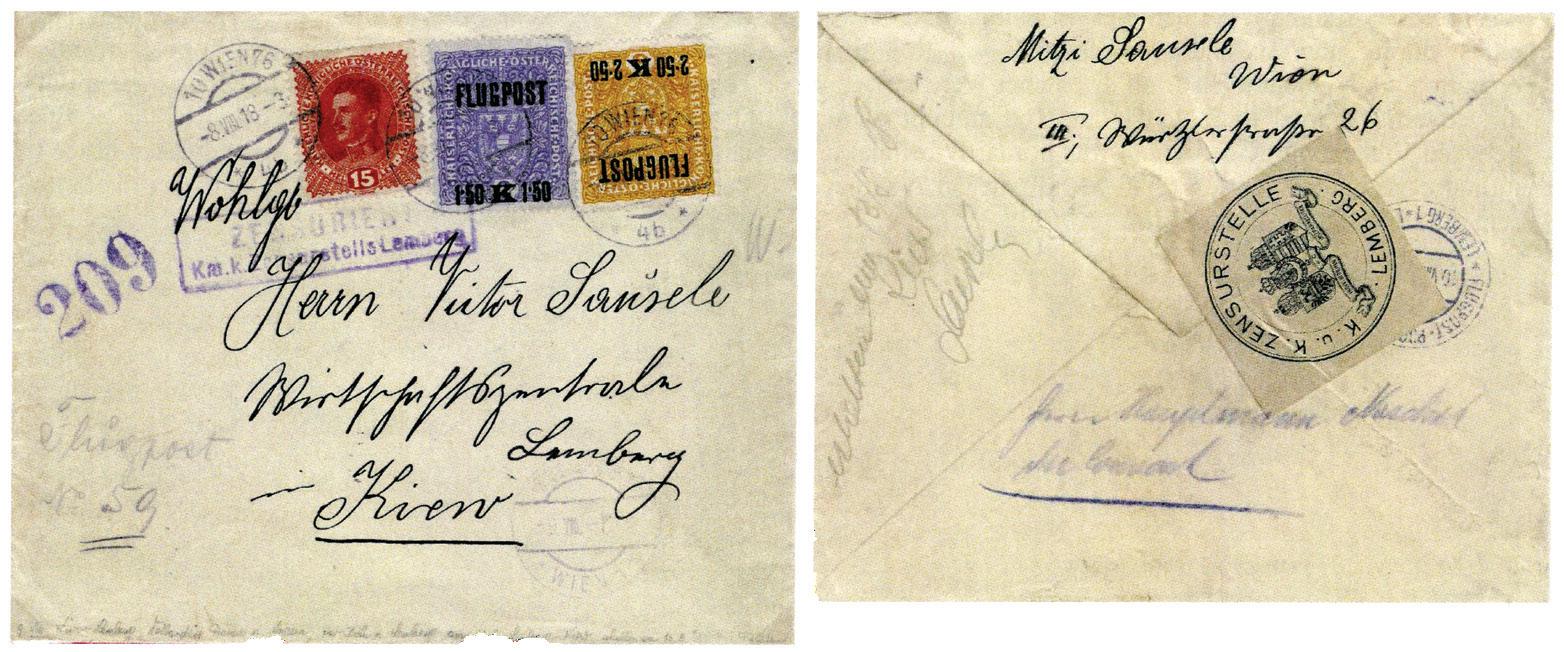
revealed that some “facts” propagated for decades in the philatelic literature about airmail services in the Habsburg Monarchy were distorted or untrue. Conflicting data in the literature triggered more in-depth research of my own, as well as discussions with other collectors. I believe my book is a testament to how rewarding it is to dig a little “deeper” while researching a postal item. To do so opens a window on history, providing avenues for further studies and the satisfaction therefrom.
Poland’s location in the center of the continent, combined with her size (ninth largest country in Europe) and population (32 million inhabitants in 1931), made her an attractive strategic partner in the race to establish new air routes. Furthermore, Poland did not exist as an independent state for 123 years, between 1795 and 1918, and as a young state faced challenging socio-economic conditions within the country – not to mention an ever-changing geopolitical situation in inter-war Europe. This means that any study of Poland’s philately must contend with its history, including challenges of unifying Poland’s postal system, airmail services, and infrastructure of airfields.
Although recognized in the philatelic literature, the essential contributions of Polish airmail services to the development of global aerial communication have not yet been appropriately acknowledged in philatelic literature. Indeed, the maturation of the aviation industry in the 1930s enabled same-day mail service between Poland and European capitals and major cities, a timeframe not necessarily readily matched by the less-efficient postal operations of this century. Expanding collaborative efforts between Polish and foreign air carriers was logical and economical. For many people, the transatlantic air service was also a critical link to the free world. This provided a possibility for communication and, eventually, opportunities to escape the terrors of World War II.
There could not be a more prominent and proper historian than Oxford-based Professor Norman Davies to write a foreword to a book by an amateur aeropostal history student, i.e., yours truly. A Nobel Prize nominee, known for his books on the history of Europe, Poland and the United Kingdom, Davies wrote and published a two-volume study, To and From: Modern

Poland, a Journey through Postal History, 1850-1939.
Although we never met in person, Davies and I frequently communicated by email. I was thrilled to receive his foreword piece in the spring of 2021, in which the very first paragraph reads, “… the present volume could be likened to a patch of the past viewed through a wide-angle microscope.” This is exactly how I initially embarked on this particular aerial postal history project, by attempting to dissect its multiple layers and facets underneath. I was equally honored by Davies’ concluding statement, “It is incumbent on philatelists and postal historians around the world to break the bounds of their national compartments and introduce their work to the broader, global community. In this regard, Dr. Kupiec-Weglinski’s work belongs to a select company of landmark publications.”
Then, Davies continues: “One recurring problem, which blights both History in general and Postal History in particular,
is posed by so-called Eurocentrism, which overstates the pre-eminence of Western Europe. At this point, one begins to see why Dr. Kupiec-Weglinski’s work must be regarded not merely as a valuable addition to existing literature but also as a healthy corrective. By expounding the aerophilately of Poland and drawing attention to Poland’s rich postal history, he is by no means competing with or dismissing earlier work on Western countries. After all, nothing can change the fact that the postage stamp era was initiated in Great Britain, or the art of ‘timbrologie,’ as philately was then called, was launched in France. Yet clearly, Dr. ‘JKW’ is not only filling an essential gap in the existing jigsaw puzzle of knowledge; he is also showing that general conclusions must always be kept under review.”
As my research has documented, widespread assertions of “firsts” must always be treated with caution. I will demonstrate with three examples from my book.
The Przemysl airmails of 1914-1915 illustrate the first time in history that mailladen airplanes landed and took off within a surrounded fortress (Figure 3). This fact is not recognized in philatelic histories. Noteworthy about this venture is that unlike others that followed, these airmails were not philatelically motivated. In addition, the Przemysl balloon post of 1915 should be compared favorably with the more famous balloon flights from besieged Paris during the Franco-Prussian war in 1870-1871.
Philatelic history currently recognizes that the first regular airmail service was established by Royal Engineers’ Postal Section, which sponsored a series of flights between Folkestone, UK, and Cologne, Germany, in December 1918. However, the true pride of place in that category should be held by the Austrian army, which established a regular airmail service in March 1918 on the Vienna – Krakow – Lemberg – Kiev route (Figure 4).
By the end of 1937, LOT Polish Airlines exclusively serviced the longest air route
in Europe (Helsinki – Warsaw – Athens – Lydda). The travel time from Finland to Palestine, a distance of some 2,700 miles (4,300 kilometers), was shortened from 10 days to just over 34 hours (Figure 5). The Middle East connection, known as the “Levantine line,” was very profitable as a growing number of European tourists visiting Egypt and Mesopotamia were using it. It has not been widely recognized that a large portion of British mail to the Middle and the Far East was now passing through the Polish airmail network, which was faster than the Imperial Eastern route via Egypt. Clearly, Western Eurocentrism has affected the foundation of contemporary (aero) postal studies.
I conclude on an artistic note. My wife of 30 years, Kasia Kupiec-Weglinski, neither a stamp-collector nor a postal history student but an “aerophilately tolerator,” has ultimately learned to understand and perhaps even accept my hobby. As a professional painter and print-maker, she contributed her artistic touch to the final product and designed the book cover, obviously the major components of the overall success.
The Philatelic Literature Review depends on APRL and APS members, who provide much of the content of this journal. We would like to encourage more people to join our roster of philatelic writers for the Philatelic Literature Review. The journal publishes a wide range of articles, on topics that include the following: how to conduct philatelic research; old and new philatelic literature; archives and library collections; book reviews; writing and research advice; profiles of philatelic figures; the future of philatelic research, and more. If you have an idea for an article or are interested in becoming a regular contributor, please send an email to plrarticle@stamps.org. For information about APS writing guidelines, visit aps.buzz/writeap.
ITis thought-provoking to reflect upon the fact that in 2022, it will be 160 years since the publication of the first periodical in the world devoted to philately. The Monthly Advertiser appeared in December 1862 in Liverpool, England, quickly changed its name to The Stamp Collectors’ Monthly Advertiser (with No. 2 of January 1863) and finally to The Stamp Collectors’ Review and Monthly Advertiser (with No. 3 of February 1863). It then appeared regularly under the latter title until No. 19 of June 1864 when it abruptly ceased publication.1
Such was the popularity of stamp collecting that philatelic magazines quickly appeared in other countries, firstly in Europe – Belgium in February 1863 (Le Timbre-Poste by Jean-Baptiste Philippe Constant Moens) and Germany in May 1863 (Magazin für Briefmarken-Sammler by Zschiesche und Köder), then North America in February 1864 (The Stamp Collector’s Record by Samuel Allan Taylor) (Figure 1) with France being the fifth entrant in the field in July 1864 (Le Collectionneur de Timbres-Poste by M. Maury Fils).
Surprisingly, the first North American philatelic magazine was not published in the United States, rather it was published in Montreal, Canada. The Stamp Collector’s Record appeared on February 15, 1864, pub-

lished by a young Scottish immigrant, Samuel Allan Taylor.2 In fact, this was the only issue he published in Canada, although he was said to have told that great American bibliophile John K. Tiffany that a second issue had been produced, but only five or six copies of the latter were circulated, the rest being destroyed.3 Interestingly, Taylor’s publishing two issues from Montreal was first mentioned by Lyman H. Bagg4 seven years before it was mentioned in print by Tiffany. Many people quote the Montreal publication as if a second number is known, however, no copy has ever been found.
Within months, Taylor had moved from Montreal to Albany, New York, and it was from there that he began publication of the second series of The Stamp Collector’s Record in December of 1864, starting again with number 1. Thus, it fell to Taylor to be the publisher of the first philatelic magazine in North America and the first philatelic magazine in the United States, making the U.S. the sixth country to issue a magazine devoted to the hobby.
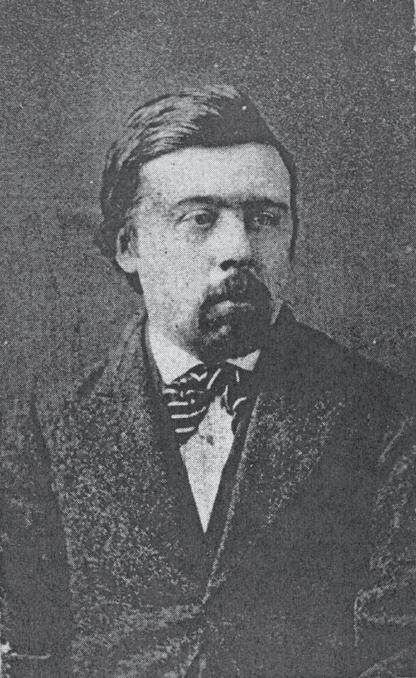
Although the second series appeared fairly regularly for the first three years (33 issues), its appearance became more infrequent, presumably as Taylor’s fortunes waned, or perhaps he got even busier, and only a handful of issues appeared during the last five years of its life. The last issue was dated October 1876, No. 44. As copies numbered 12, 42 and 43 were never published, it ended with 41 issues, plus an “extra” edition in March 1865.
As the first North American philatelic periodical, The Stamp Collector’s Record of Montreal is a great bibliographic treasure, all the more so owing to its great rarity. As recently as 1945, Canadian researcher Raymond A. Jamieson claimed that there was no copy of the first issue in Canada.5 It has been said that even today, only a handful of copies are known to exist – quite believable if one reviews some major philatelic libraries:
Royal Philatelic Society London | Yes – copy widely illustrated5
British Library | Yes – copy in the Crawford Library presumably acquired with the J. K. Tiffany library1
University of Aberdeen Library | Yes? - copy from P.J. Anderson6
Collectors Club | Photocopy from The Royal Philatelic Society London7
American Philatelic Research Library | Photocopy from the British Library Library & Archives Canada | Yes, three copies5
Smithsonian National Postal Museum | Yes - bequest of George Townsend Turner8
As can be seen from the list, the Royal Philatelic Society London has a copy of the Montreal edition and, indeed, the complete second series of Taylor’s magazine bound together in a small nondescript volume. In fact, it was coming across this volume, a casual perusal and realization of the significance of its contents that led me to write this. Photocopies of the Royal’s first number of the Montreal edition are the most widely distributed and illustrated versions of The Stamp Collector’s Record. The origin of the Royal’s copy will be related in a subsequent article.
The Collectors Club of New York acknowledges the Royal as the source of its copy.7 Surprisingly, a reprint of pages 1, 3 and 4 of the Royal’s copy was distributed by The Stamp Collectors’ Exchange Club, of Hickson, Ontario, Canada, in the mid-1930s as part of a recruiting leaflet, announcing proudly, but quite incorrectly, that “The only known copy of this publication is in the library of the Royal Philatelic Society, London, England.”
The British Library’s copy is easier to trace since it is in the library of the Earl of Crawford and came to that as part of the Tiffany library which was purchased in 1901 by the earl.9 An inquiry with the American Philatelic Research Library in 2009 revealed that its copy was provided by the British Library.10
In spite of the fact that Taylor (Figure 2)11 is one of the most renowned of the early American stamp dealers and a producer of forgeries, fakes and fantasies, I have never seen any attempt at analyzing exactly what he published in that first Montreal issue – perhaps not surprising, owing to its great rarity. Accordingly, a brief table of contents follows:
Editorial matter
Editorial: To our readers | p.1
Canada 1c Newspaper Wrapper Stamp (Fake) | p.1
New Brunswick 2c yellow | p.1
Answers to correspondents: | pp.1-2
J.K., Kingston
A.L.D.
A Collector
C. de L., Quebec
H.W.B.
American Trick | p.2
(Selling a “beautiful steel engraving of General Jackson, the hero of New Orleans” for 25¢ and receiving a current U.S. 2¢ stamp.)
Apart from the magazine’s subscription and advertising rates, the remainder of the pages are devoted to advertisements – mostly by Taylor. Even at this early date, Taylor’s emphasis on dispatch companies and other locals is shown by his listing for sale the stamps of no fewer than 38 such organizations. In spite of a number of “wanted” advertisements from Taylor, J.A.N. (John Appleton Nutter – an acolyte of Taylor) and J. – all of Montreal, none of the locals are listed as “wanted.” The following advertisements are included in the issue:
C.G. [C. Gloyn] Stamp dealer of Acomb House, Manchester, UK, (Agent for the Record) | p.4
D. Rose, (Printer of the Record) | p.4
J. P. O. Box 458, Montreal | p.4
J.A.N., P. O. Box 519, Montreal, [John Appleton Nutter] | p.4
James Ross, (Photographic artist) | p.4
Samuel A. Taylor | pp. 2, 3, 4
William Dalton, Stationer, (Seller of the Record) | p.4
A list of the dispatch companies and other North American locals listed in Taylor’s ads
is given, followed by a list of Confederate locals. Wherever possible, I have given the full name of the service. Non-existent services are marked as “Bogus,” followed by the name of the main perpetrator.
Taylor’s List
3rd Avenue P.O.
American Express Co.
Full name of local12, 13, 14
Third Avenue Post Office, New York
American Express Company, New York
Arthur Arthur’s City Express (Bogus – Taylor)
or
Arthur’s City Post (Bogus - Taylor)
Bentley Bentley’s Dispatch, New York
Blood
D. O. Blood & Company, Philadelphia
Boyd Boyd’s City Express, New York
Brady & Co. Brady & Company, New York
Broadway P.O. Broadway Post Office, New York
Brooklyn City Brooklyn City Express Post, Brooklyn
Chatham Square
?
City Express Post City Express Post, Philadelphia
Clark & Co.
Clark & Company, New York
Floyd Floyd’s Penny Post, Chicago
Grafflin Grafflin’s Baltimore Despatch, Baltimore
Hunt Hunt’s Despatch (Bogus - Taylor)
Hussey Hussey’s Post, New York
International Express International Express (Bogus – Hussey*)
Jenkins Jenkins’ Camden Dispatch, Camden
Ker Ker’s City Post (Bogus – Taylor)
McIntire McIntire’s City Express Post, New York
Metropolitan Metropolitan Errand and Carrier Express Company, New York
or Metropolitan Post Office, New York
Moody Moody’s Penny Dispatch, Chicago
New Jersey Express
?
Pony Express Wells, Fargo & Company
Robinson (more likely, “Robison”) & Co. Robison & Company, Brooklyn
Smith’s City Express
Squier & Co.
Smith’s City Express Post
Squier & Co. City Letter Dispatch, St Louis
Union Square Union Square Post Office, New York
Warwick
Warwick’s City Dispatch Post (Bogus –Hussey*)
Wells Fargo Wells, Fargo & Company
Winslow Winslow & Co. Express (Bogus – Taylor)
*Hussey not only had his own genuine local post, under his own name, but also created bogus posts and forged the stamps of other genuine and bogus posts.
Confederate Locals:
Baton Rouge
M.C. Callaway [Memphis, TN]**
Memphis
Nashville
New Orleans
**These Confederate locals were issued during the Civil War as local supplies of normal Confederate stamps ran out. Many postmasters resorted to issuing their own stamps and often included their name on the stamp as an additional validation. Callaway’s first issue included his name but not that of the town, Memphis.
It is notable that even at this early date, Taylor was purveying bogus issues of his own creation as well as those produced by others. In all likelihood many of the stamps he offered from genuine posts would also be forgeries. It is perhaps all the more ironic that on the first page of his journal he warns his readers that the Canada 1-cent Newspaper Wrapper stamp is bogus - although obviously not one of his making!
A full list of agents and sellers of the journal is provided:
Montreal
William Dalton
T. Riddle
C. Hill
Foreign
C.G., Manchester, U.K.
Leon Chandelier, Le Havre, France
E. G. Wilking, Boston, U.S.
W. P. Brown, New York, U.S.
At the time he published The Stamp Collector’s Record, Taylor was presumably trading from his residence at 14 Cheneville St., Montreal, and had his business correspondence addressed to Box 934, Montreal. It is somewhat incongruous that, in view of his now wellknown nefarious activities, he states boldly in his editorial “… our influence may not be purchased either through fear, favour, affection or hope of reward.”
There is little doubt that Taylor intended this to be the first of many issues of his magazine since he gave subscription rates – 50 cents Canadian and 62 cents to American addresses – along with the advertising rates on the second page. However, it must have been around the time that the second issue was due to have appeared in March 1864 that Taylor moved to Albany, which would account for the March issue, which he had evidently prepared and had printed, technically not being published. It was in December of the same year that the first issue of the new series appeared from Albany.
1 E. D. Bacon. Bibliotheca Lindesiana Vol. VII: A Bibliography of the Writings General, Special and Periodical Forming the Literature of Philately (Aberdeen, UK: Aberdeen University Press, 1911).
[Reprinted as: E.D. Bacon. Catalogue of the Philatelic Library of the Earl of Crawford, K.T., (London: The Philatelic Literature Society, 1911.)]
A Supplement was published as: E.D. Bacon. Supplement to the Catalogue of the Philatelic Library of the Earl of Crawford, K.T. Published 1911. (London, UK: The Philatelic Literature Society, 1926).
An Addendum was published as: Sir Edward D. Bacon K.C.V.O. Addenda to the Supplement to the Catalogue of the Philatelic Library of the Earl of Crawford, K.T. (London, UK: The Royal Philatelic Society, London, 1938). Published as a supplement to The London Philatelist of March 1938.
Volume VII, complete with the Supplement and Addenda, were reprinted as: Catalogue of the Crawford Library of Philatelic Literature at the British Library (Fishkill, NY: The Printer’s Stone (in association with the British Library), 1991).
2 Jan Kindler. “Caveat Emptor, The Life and Works of S. Allan Taylor,” Philatelic Literature Review 15, no. 2 (June 1966): 59-77 and 80-89. The reproduction is from a photostat in the collection of the Reverend John S. Bain of Santa Rosa, California, which was taken from the original in the library of the Royal Philatelic Society London.
Kindler relates that he knows of only two other copies: one in the Crawford Library in the British Museum, now at the British Library, and the other in the library of George T. Turner, which is now presumably at the Smithsonian National Postal Museum. (See reference 8.)
3 John K. Tiffany. “The Philatelical Library. A Catalogue of Stamp Publications.” Privately printed by Tiffany, St. Louis, Missouri, 1874. Tiffany had mentioned three years earlier in an unpublished work that two numbers of the Montreal edition existed: John K. Tiffany. A Reference List of Publications Relating to Postage-Stamps and their Collection Compiled by Request for the Boston Public Library (St. Louis, MO: Prepared by John K. Tiffany, 1871).
4 Lyman Hotchkiss Bagg. “American Philatelic Literature,” The Philatelist 1, no. 6 (May 1867): 90-92.
contemporary philatelic literature collector, lists two issues of The Stamp Collector’s Record from Montreal some years before Tiffany.
Bagg sold his small library of very early literature to William Carlos Stone in 1907. Following Stone’s death in 1939, his library was bought by George Townsend Turner. [George T. Turner. “Contemporary notes of the interesting “pioneer days” of philatelic literature,” Linn’s Weekly Stamp News 26, no. 50 (February 22, 1954): 1 & 10.]
5 R. A. Jamieson. “Looking backwards,” Popular Stamps 11, no. 3 (April 1948): 19-20.
The author provided a list of the 22 most important periodicals to have been published in Canada. Although the list starts with The Stamp Collector’s Record, he was only able to illustrate it with a copy from the Albany series of the magazine, which he claimed are the only copies of Taylor’s magazine in Canada. The Canadian references below indicate the debt owed to the Royal Philatelic Society London for copies of the first issue:
R.J. Duncan. “Index to Canadian Philatelic Magazines: ‘The Stamp Collector’s Record’,” BNA Topics 5, no. 5 (May 1948): 70-71. Includes a very brief note about The Stamp Collector’s Record, the illustration courtesy of R. King-Farlow, Honorary Librarian of the Royal Philatelic Society, London.
A. L. McCready. Canadian Philatelic Literature (Cobden, Ontario, Canada: A. L. McCready, 1951).
The Stamp Collector’s Record is listed and illustrated on page 16. The illustration is acknowledged to have been provided by the Royal Philatelic Society, London, through Robert J. Duncan and is said to be the only known copy.
By 1987, a copy of the Montreal edition was known to be held by the Canadian National Postal Museum.
James W. Brennan. “Canada’s National Postal Museum will be on display at CAPEX ’87,” The American Philatelist 101, no. 6 (June 1987): 551-555.
A report on Canada’s National Postal Museum’s proposed display for the Canadian National Philatelic Exhibition CAPEX ’87. The exhibit included an original copy of The Stamp Collector’s Record, the front of which is shown.
An article about Canada’s National Postal Museum, also published in 1987, claimed that only five copies of the Montreal number 1 were known. (Francine Brousseau. “The collection of Canada’s National Postal Museum,” Canadian Philatelist 38, no. 3 (May/June 1987): 196-214. (In English and French.)
I believe that the National Postal Museum Canada was incorporated into the Library and Archives Canada. My enquiry to them in March 2011 brought the response that the organization holds three print copies of the Montreal edition number 1. (Sandra Bell,
e-mail, March 18, 2011)
6 Peter John Anderson. Rough List of Specimens of Philatelic Literature (mostly of early date) from the Aberdeen University Library shown to the Aberdeen and North of Scotland Philatelic Society on October 11, 1911. (Aberdeen, Scotland: Aberdeen University Press, 34 pp.) Reprinted as: [Peter John Anderson]. “List of exhibits,” Aberdeen University Library Bulletin 1, no. 3 (April 1912): 339-368.
The lecture was written up as “Early philatelic literature. An interesting lecture by Mr. P. J. Anderson at Aberdeen,” The Postage Stamp 9, no. 6 (Nov. 4, 1911): 63-64. Reprinted from The Aberdeen Free Press (Oct. 13, 1911.)
Taylor’s journal is not mentioned in the write-up.
One of the exhibits listed in Anderson’s “Rough List” was The Stamp Collector’s Record no. 1 from Montreal, with autograph letters inserted. Fortunately, Anderson kept a diary in which he recorded the receipt of this file of the journal, bound in half morocco, from John K. Tiffany on December 10, 1877. (P J. Anderson. “Philatelic literature collecting in 1864-79,” The Journal of the Philatelic Literature Society 11, no. 1 (January 1918): 1-6 & no. 2 (April 1918): 17-21. Reprinted as P. J. Anderson. Philatelic Literature Collecting in 1864-79. Reminiscences and Extracts from a Diary (London, UK: Printed for the Author in an edition of 30 copies, 1919, 47pp.)
An inquiry about their copy of the journal with the Special Libraries and Archives at the University of Aberdeen in October 2009 resulted in the response that they no longer held any issues of The Stamp Collector’s Record. E-mail from June Ellner, January 22, 2010. She presumed that it had been de-accessioned from the library stock some time after 1911.
7 Bruce Rutherford. The Collectors Club Library: Gems of Philatelic Literature (New York: Collectors Club, New York, October 1992, 11 pp). This printed report on the club’s Rare
Book Evening includes a partial run of The Stamp Collector’s Record, noting that the first number from Montreal is represented by a photocopy from the Royal Philatelic Society, London.
8 George T. Turner (February 11, 1906-August 14 1979 (National Postal Museum’s website: www.postalmuseum.si.edu, 2020). The write-up noted that … the Smithsonian Institution received the Turner library’s finest items, totalling over 3,000 books and related material. Since Turner was known to have had a copy of the Montreal number 1 (See reference 2.), it would undoubtedly have been amongst the books bequeathed to the Smithsonian.
9 Ronald Negus. The Earl of Crawford K.T. A Short Biographical Sketch (Royal Philatelic Society London, 2002, 24 pp). Published as a supplement to The London Philatelist of December 2002.
10 In May 2009, I inquired of the American Philatelic Research Library as to their holdings of The Stamp Collector’s Record. Ellen Peachey replied that the library’s photocopy of Montreal number 1 was provided by The British Museum. That this situation has not changed in the past decade or so has been confirmed by Marsha Garman as recently as October 25, 2021.
11 Irving I. Green. “Hawaii: S. Allan Taylor Solves an 1861 Issue Mystery,” The Collectors Club Philatelist 42, no. 3 (May 1963): 141-147. The photograph is courtesy of the Philatelic Foundation.
12 1989 Specialized Catalogue of United States Stamps (Scott Publishing Company, 1988).
13 Larry Lyons. The 2007 Pricing Guide for Unlisted Carriers, Locals, Fakes Forgeries and Bogus Posts of the United States (Larry Lyons, 2007).
14 David F. Sessions. Philatelic Fantasies of British North America (1860-1910) (Waterford, Michigan: Charles G. Firby, 1999).


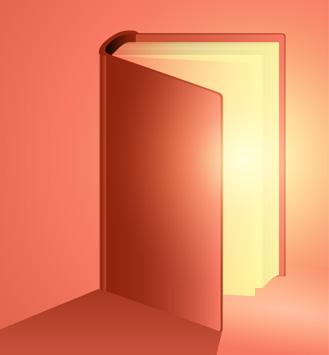
Reference work at the American Philatelic Research Library is very interesting work; it’s also very challenging. On any given day, I may receive requests for information on luminescence on stamps, local or bureau precancels, cover information (cachets, cancels, or other markings), identification of stamps, perfins, postcards, or feuillets de luxe (some what?), or the incredibly complex postal rates and routes. I never know what to expect.
After nearly two years in my position as the reference assistant, I don’t believe I have made it through one day without learning something new. Well, if not learning, at least I have been exposed to something new. I love my job, but sometimes I feel overwhelmed by what I still do not know. Where do I start?
Here, I will share the broad strokes I take in my approach to answering your research requests. In subsequent columns, I will get down to the nitty-gritty research for specific topics and the resources available in our library.
Some requests are easy. Can you give me the Scott catalog value for the French airpost stamp C17? Absolutely!
Most requests, however, require more digging. Sometimes the digging starts with going back to the patron. At times, the requests I receive are too broad: Can you send me a catalog on locals? Or too cryptic: I have an old 2-cent stamp with a woman in a veil. Can you identify it? These requests require my getting back to the pa-
tron to clarify their needs. Which country, state, city or type of locals are you researching? Can you send an image of your 2-cent stamp for identification?
On the other hand, the lack of information may be due to gaps in my knowledge on the subject. What is a feuillets de luxe anyway? Is Kiribati a country? Where is Dahomey located? When my knowledge on a particular topic is lacking, I start with an internet search. A quick search will usually give me enough background on an
What is a feuillet de luxe?
An introductory paragraph from Catalogue Officiel NET Belgique 1986 about Feiullets de luxe is translated by Google as follows: “[These sheets with unperforated stamps and in the original colors, are issued by the Regie des Postes and have no postage value.]”
The sheets I have found in the catalogs commemorate a special event. I have found feuillets de luxe listed with several countries: Belgium, Democratic Republic of the Congo, Zaire, and Rwanda, to name a few. These sheets are collected by some of our members and, from what I have seen from the catalogs, they sell for a much higher value than the stamps
As I am not an expert on feuillets de luxe, I would appreciate any further insights or corrections about this genre.
unknown subject to enable me to begin my search in the library.
Once I have a clear idea of what I am looking for, I start with the library catalog. I search the catalog in two ways, depending on the type of material I am trying to find. If the patron is looking for material that is specific to the APRL – such as books, catalogs, or archival material – I will limit my search to our library’s online catalog. Using keyword searches on various related terms will usually find some material on the subject if we have it.
If I don’t find anything through my first search, or if the patron is looking for journal articles, I will do an “articles” search. Article searching is a new feature in our upgraded catalog. I find it very helpful. Article searching is not limited to the APRL, so the results will return titles that have been indexed by several libraries, usually resulting in some positives hits on the subject. The APRL journal holdings include nearly all journal titles held by the other libraries in our shared database, so if a title comes up in the results list, it will most likely be available through our library even if it has been indexed by another library.
Many requests can be answered through a catalog search, but if I still haven’t found something, or if what I have found doesn’t fully answer the request, I will look through a relative index/bibliography, search our Digital Library journals, or take a look in the archives for more information.
If I still come up empty, I will try to con-
tact someone with expertise in the field who may have the answer or can point me in the correct direction.
Once I have pulled the materials from my search, I will review them to see if they contain the information the patron seeks. I have found that even though the title and/ or subject terms seem to point to a correct resource, when I review the material I find there is minimal information (or none) on the desired subject. On the other hand, if I find the resource is spot on, I may look for additional material on the subject in its bibliography. I have found some of the best resources in this manner.
After gathering some possible resources, I will email or call the patron with my annotated list to see if they are interested in having anything sent. I include a reminder of the cost to borrow materials or have pages scanned. Sometimes the patron will have further information or detail that will require me to do more research, and the process begins again. It’s a good thing I love this work!
In my next column, I will discuss the resources used for finding federal and state revenue stamps.
To make a reference request, contact Marsha at mgarman@stamps.org. There is no charge for reference requests that take relatively little time. Research work, however, is charged at $20/hr. You will be notified if your request is considered research work and be given an estimate for the amount of time it may take to complete.

The Twelfth Winton M. Blount Postal History Symposium
December 8-9, 2022
Smithsonian National Postal Museum, Washington, DC
Sponsored by the American Philatelic Society, American Philatelic Research Library, and Smithsonian National Postal Museum
In countries around the world, postal administrations and their missions, practices, and regulations serve as reflections and agents of state goals and ideals. Like the administrations, be they privatized, quasi or fully governmental, these ideals and goals can vary widely. In all cases, they shape the relationship that citizens, subjects, or residents have to the mail and the post office, including their expectations and decisions on how and when to use them. By sending and receiving mail or by using other offered services, individuals participate in communities or networks — familial, commercial, social, or other. Moreover, the acts of using and engaging — even the potential for these — with postal services may simultaneously reinforce and challenge the postal administration and its political foundations.
Possible themes involving the interaction and influence of the state, postal administrations, and the public include:
• Regime change and its impact on postal services
• Politics and economic systems determining governmental, quasi-governmental, and privatized structures
• Postal regulation and legislation as relate to postal users
• Postal contracting and subsidies
• Relationship of politics to employment with the postal administrations and industries
• Privacy, surveillance, censorship of mail
• Innovation, adoption, adaptation, and removal of non-mail postal services
• Representations of political ideas on stamps
• Advertising and propaganda covers
• Postal regulations, laws, and the public
• Mail as a tool or site of formal and informal community development and/ or political activism
• Letter-writing campaigns and correspondence circles
Deadlines for proposals:
One-page proposal and CV due May 4, 2022. In addition to a one-page proposal stating the question/s to be answered, the basic argument, and the source base, each individual should submit a one-page curriculum vitae that includes contact information (e-mail, phone, address) tos mithsu@si.edu.
Notification of acceptance will be mailed on or about May 25, 2022. Although we are planning to hold the event in person, sessions will be streamed for viewing from home and slide shows and abstracts will be available online after the event. Presenters should plan to attend the event in person.
Papers due by October 15, 2022. Accepted proposals must result in previously unpublished papers of 5,000-6,000 words, including bibliographic mate-
rial and citations. Event organizers are hoping presenters will consider the symposium an opportunity to receive feedback on their papers and are willing to facilitate the placement of publications in postal history and philatelic journals.
For more information and updates regarding the 2022 Postal History Symposium please see the Symposia and Lecture page on the National Postal Museum’s website at https://postalmuseum.si.edu/symposia-and-lectures.
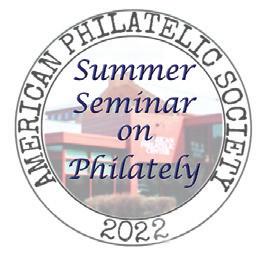
JUNE 19-23, 2022
AMERICAN
PA
Registration is now open for Summer Seminar on Philately! Learn more and register online at aps.buzz/SummerSeminar.
Seminar courses are taught by philatelic experts. Enjoy learning with others who share your passion!
2022 Course List
Kansas-Nebraska Overprint Stamps
Solving Auxiliary Marking Puzzles
Forensic Philately (Courses FULL) Intro to Russian Philately
Harding to Hoover: Stamps in Context Intermediate/Advanced Philatelic Exhibiting The Philately of the British Machin Stamp
stamps.org/learn/summer-seminar

The 19th Century Issues of El Salvador 1867-1900. By Guillermo F. Gallegos and Joseph D. Hahn. 894 pages, casebound, 9 inches by 11½ inches.
Published by Royal Philatelic Society London, 2021. ISBN 978-1-913015-145. Price £70 plus shipping from https:// www.rpsl.org.uk/Publications.
This splendid handbook, based on decades of research and writing, reveals the rich treasury of the 19th century postage stamps of El Salvador in Central America. Preliminary notes outline the format for the manual’s entries and the abbreviations used. This is not a priced catalog.
For each of the stamp issues the history and examples are shown, using government decrees, proofs, essays, color trials, specimen stamps, counterfeits and forgeries. The first chapter summarizes the postal system before the emergence of the Universal Postal Union in 1879. The following chapters deal with each issue, showing rare archival material, printing and varieties, recorded uses with cancellations and bogus examples. Postal stationery released during this period is incorporated chronologically in the listings. There is a detailed description of the complex Seebeck issues and the Hamilton Bank Note Engraving and Printing Co.
The handbook uses its own numbering system and includes a concordance with the numbers in the Scott, Michel, Yvert & Tellier, and Stanley Gibbons catalogs. One appendix discusses telegraph stamps and another lists cancellation types used on each of the stamp issues. A glossary of

Spanish terms, extensive bibliographic references and an index conclude the book. The layout is beautifully presented with excellent illustrations. This book is the definitive resource for studying the stamps of El Salvador in the latter half of the 19th century. Only 100 copies have been printed.
Reviewed by Alan Warren
2022 Newfoundland Specialized Stamp Catalogue, thirteenth edition. By John M Walsh, et al. 928 pages, extensively illustrated, 9 by 15¾ inches, digital format. Published semi-annually by the author. 13th edition: ISBN 978-1988823-04-1. Price $100 available only from the author's website as an eCatalog, www.nfldstamps.com.
The 2022 Newfoundland Specialized Stamp Catalogue is the most valuable tool a serious collector of Newfoundland can possess and an invaluable resource for the postal historian.
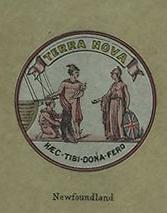
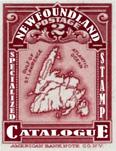









This is clearly one of the (if not the) most comprehensive one country philatelic catalog in existence. This is not hyperbole. The introduction alone is 48 pages, including a nine-page table of contents. Using a unique catalog numbering system, this catalog covers every imaginable aspect of Newfoundland philately, from stamps, proofs and covers to revenues, picture post cards and even advertising and corner cards, all logically laid out and priced in U.S. dollars at current market prices.
Stamps are priced both mint and used in VF condition with premiums given for NH; with quantities printed noted and quantities known for rare items given. On-cover usages are also priced, along with quantities known to exist. Besides stamps and covers are extensive listings of all the known essays, color trials, die and plate proofs, specimen overprints, trade samples, reprints, forgeries, varieties, cancellations and much more, all profusely illustrated, the varieties
magnified for detail. There are also sections
ing tobacco stamps, War Savings stamps, perfins, town cancels, postal stationery, picture post cards and even advertising and

For the postal historian we have not only the on-cover pricing and census, but also dates of earliest known usages, background history of the Newfoundland postal system, stampless and adhesive postal rates, a list of known post offices and their cancels, illustrations of postal markings and obliterators used in various periods. The catalog is also replete with specialized articles by the author and his numerous contributors.
In conclusion, there is much more to this fantastic catalog than can be covered in this review.
Reviewed by George Evelet.
Norgeskatalogen Postal III. By Oslo Filatelistklubb. 384 pages, card covers, perfect bound, 17 by 24 cms (6¾ by 9½ inches).
Published by Oslo Filatelistklubb, Oslo, Norway, 2021. ISBN 978-82-93453-05-5. Price 425 NOK (approximately $50) plus shipping and handling outside of Norway, available from https://www.oslofilatelistklubb.no/norgeskatalogen-2022/. Following in the footsteps of Sweden’s

FACIT Postal postal history catalogs, the publications committee of the Oslo Filatelisklubb continues with this third edition of the Norwegian postal history catalog. The new edition carries corrected and updated entries, and additional cancellations contributed by collectors and the committee itself.
The introductory text, in both Norwegian and English, provides definitions of abbreviations, discusses pricing, illustrates the various levels of quality and the basic types of cancellations, provides advice on forgeries, and finally shares a brief Norwegian/English/German vocabulary and a bibliography of references.
The postmark sections include prestamp markings, single circle marks on skilling issues, the 2- and 3-ring marks, the Swiss type cancellers, 1877-1930, and again for 1930-1936, the so-called miniature marks and the crown and posthorn cancels. Other categories are the Post i Butikk marks (used at post offices in shops), registered letters from 1855 to 1909, and tables of postage rates from 1877 to 2021.
Some of the postmark listings include
the names of cities and towns spelled alphabetically and also in reverse, to help collectors identify marks where only the last portion of the town name can be seen.
The cancellation illustrations are excellent, and some on-cover markings are also shown. The annual Norgeskatalogen is the detailed listing of the stamps of Norway and their varieties. For cover collectors the Norgeskatalogen Postal III is the reference needed to help understand the country’s postal history.
Reviewed by Alan Warren
Price Catalogue of Norwegian Air Mail 1870-2020. By Svein Arne Hansen and Finn Aune. 304 pages, 8½ by 11¾ inches (A4), hardbound. Published by Skanfil, Haugesund, Norway, 2021. ISBN 97882-92535-29-5. Price 550 NOK (approximately $65) plus shipping from Skanfil, Postboks 2030, Haugesund, Norway, or www.skanfil.no.
This new catalog fills an important need, specifically as an English language listing of significant flight covers of Norway. The tables seem rather complex on first viewing but are well structured with definitions of abbrevia-
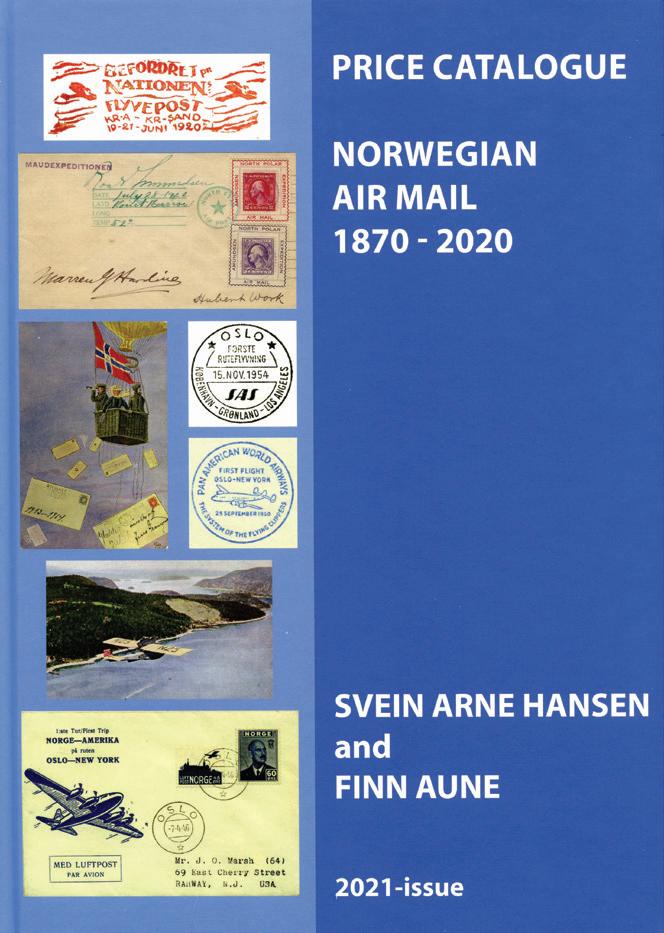
tions and notes on organization at the beginning. The book documents first flight and event covers, and sometimes first use of new routes. Airline abbreviations are defined, as well as the country that owns them.
The first column is the date of the cover, followed by a catalog number that is unique to this catalog. Next are the origin and destination cities with some notes on intermediate stops. The group column identifies the method of conveyance: balloon, catapult, special event, helicopter, polar, zeppelin, etc. The type column lists more than two dozen classes, like first flight, forerunner, airfield opening, postal stationery, air show, crash mail and others. First day covers are included for Norwegian stamps that are airmail related.
A producer column refers to individuals or organizations that sponsored first flight covers. Several columns cross-reference covers that are found in earlier handbooks and catalogs by Örjan Lüning, Egil Thomassen and Erling Stark. The last column indicates the current value in Norwegian kroner based on dealer and auction sources. There is also a checkbox for collectors to mark what they own.
The cover illustrations are small. Details are not easily seen, although special cancellations or cachets are shown enlarged next to a cover. A section near the end of the catalog lists the Norwegian airmail labels or etiquettes and their varieties. A map shows the names of the country’s airports and the cities where they are located. A brief bibliography concludes the catalog. Serious collectors of Norway’s airmail postal history will find this book is required to identify what they own or are seeking.
The evolution of this catalog is an interesting story. The co-authors decided to base it on the extensive collection of Svein Arne Hansen and the organizing skills of Finn Aune. However, Hansen’s collection stopped at 1945. Aune compiled the more recent entries and after a preliminary review of the book by Egil Thomassen, many missing items and corrections were needed. Unfortunately, Hansen became ill and died in 2020 before the catalog was published.
Reviewed by Alan Warren
The Western Express Companies, 18501890: Their History, Printed Franks and Handstamps, 3rd edition. By Oscar M. Thomas. 1,122 pages in two volumes, 8½ by 11 inches, casebound. Published by United Postal Stationery Society, Chester, Va., 2020. ISBN 978-1-7327880-6-0. Price $150 postpaid to USA addresses from United Postal Stationery Society, Inc., PO Box 3982, Chester VA 23831 or upsspubs@aol.com.
This work was first published in 2013 and in 2017 was updated in electronic form. Oscar Thomas was working on an exA

panded edition when he died in 2016. With the support of James Blaine, Scott Prior and Ken Stach, Oscar’s work was completed, resulting in this third edition. The twovolume book is closely associated with the Western Cover Society. Many of the illustrations are from the society’s library and are identified with WC numbers.
Volume 1 covers the company names from A through L, and Volume 2 is devoted to M through Z. The entire table of contents appears in both volumes with the name of the company and the page where it is listed. The purposes of the western express firms were to provide safe and rapid transport of letters, packages, gold dust and specie (money).
The “franks” could be manuscript, handstamped or printed. They contained the company name, sometimes the town where they operated, and whether the charges were paid or due. There were also auxiliary markings (all in capitals) such as “paid, not paid, collect, free.” Each of the markings is assigned a catalog number consisting of a three-letter abbreviation for the firm’s name and a three-digit number. The numbers are divided into groups. The 100 series is for handstamped and manuscript marks, the 200 series is auxiliary markings, the 300 series is forwarding agents, the 400 series is for printed or handstamped corner cards, etc. The 800 series numbers are for fakes and forgeries.
The companies are listed alphabetically and begin with text that describes where they were located and when they operated. Listed also are the names of the individuals or partners. For example, Bamber & Co.’s Express was established by John Bamber, who served as owner or manager from 1858 until 1873. In 1874 it came under the new management of A.D. Whitney, F.H. Smith, B.F. Moore and E.M. Hall, but continued to operate as Bamber & Co.’s Express until it was renamed Whitney & Co.’s Express in

1875. Much of the details came from directories that list the firms.
Many covers are also listed. The detailed descriptors indicate color, envelope type, postmarks, labels, any additional postage applied as stamps, etc. The introductory material lists the abbreviations used in these descriptors. The introduction ends with an alphabetical list of the express companies, the geographic area where they operated and the dates of operation. Each of the major company listings ends with a list of reference articles and books for background information.
The illustrations are clear and in color. Despite two volumes with a total of more than 1,100 pages, the entries are compact and contain an incredible amount of information about the express companies and their covers. For those collecting or seeking information about these firms and their mail, this two-volume handbook is an important resource.
Reviewed by Alan Warren
United States Postal Card Catalog, ed. Lewis E. Bussey. 306 pages, 8 ½ by 11 inches, hardbound, 13th edition. Published by United Postal Stationery Society, Chester, Virginia, 2020. ISBN 978-1-7327880-7-7. Price $80 postpaid in USA ($64 for UPSS members), available from United Postal Stationery Society, PO Box 3982, Chester VA 23831, or www.upss.org. For costs to destinations outside the USA, contact UPSS as shown above.
For many years UPSS publications were issued in 6 x 9 inch size, resulting in a onecolumn format. For ten years now, the larger letter-size pages seen in this catalog permit the more efficient two-column format with fewer pages needed. This new edition of the postal card catalog is also known as the 75th anniversary edition since the society was founded three-quarters of a century ago. This is a priced catalog with values shown as well as revised catalog numbers. New varieties are now listed as well as the latest cards issued by the postal service. For these reasons,

the new postal card catalog is important for collectors in this field. Introductory material includes discussion of earliest reported postmarks (ERP), the values of non-denominated and Forever cards at time of issue, surcharge varieties (inverted, double impression, on both sides of the card, etc.), counterfeit cards and overprints, and suggested ways of collecting (censored, foreign destinations, postage due, war ballot cards, etc.). Rate tables for postal cards and postcards include domestic as well as foreign use.
The catalog numbers are those of the UPSS, beginning with the letter “S” for single cards. Each entry includes date of issue, number issued, Scott number equivalent, printing format (typically 8 by 10 or 10 by 10), and major varieties (color, inverted and reversed watermarks, ERP, plate flaws). The first postal card appeared in 1873 and the single card listing in this catalog runs to 2017. The single cards are followed by message-reply cards and their surcharged varieties, from 1892 to 2017.
Some specialized types of cards have their own listings, including the Postal Buddy type, exposition cards, overprints for U.S. administrative areas (Canal Zone, Philippines, Puerto Rico), 19th century local post cards, and postal savings cards. An informative appendix discusses postal card production: dies and plates, watermarks, card stock types, fluorescent varieties, printing methods, paste-ups, and a list of contractors and paper suppliers from 1873 to date.
Concluding the catalog is a reverse subject/topical index for the three main categories of single, message-reply, and airmail postal cards. The layout and image quality enhance the listings. Just about everything a collector needs to know about United States postal cards will be found between the covers of this useful catalog.
Reviewed by Alan Warren.
We encourage readers to send their comments, questions and feedback to the Philatelic Literature Review. Your feedback, questions, concerns and suggestions help us to improve the journal.
Submission of a letter implies consent to publish, unless specifically prohibited by the sender. The decision of whether to publish is made by the editorial staff of the Philatelic Literature Review
Generally, letters will be published unless determined to be offensive, disrespectful, libelous, slanderous or not chiefly related to the stamp hobby.
The opinions expressed in a Letter to the Editor are those of the author and not the Philatelic Literature Review or APRL. We do not publish or accept requests for the publication of anonymous letters.
To allow more Letters to the Editor, you are respectfully requested to limit submissions to 500 words or less. If your submission is longer, the editorial team will ask you to resubmit a shorter version, or provide you with a copy of an edited version to review prior to publication.
Submit your letters to plrarticle@stamps.org, subject line “Letter to the Editor” or mail a typewritten copy to Letter to the Editor, The Philatelic Literature Review, 100 Match Factory Place, Bellefonte PA 16823.
Had I not had a recent exposure, I would probably have slipped right past the article on digital archives on Page 168 of the February 2022 issue of the AP [A.M. LaVey’s “Digital archives and philatelic information: A case study,” first published in the 4th quarter PLR]. Now I wonder if these archives aren’t a huge untapped resource.
In January I gave a Zoom presentation to my local stamp club, the Philatelic Society of Lancaster County, on the postal history of Lititz, Pa. from my collection. I believe I have the most complete collection that exists. While the Lititz Post Office was established in 1806, my earliest piece is dated 1822. So, I wondered aloud in the meeting, where are all of the letters between 1806 and 1822? I had indicated that the Lititz Historical Museum was of no help. Someone suggested the Moravian Church Archives (across the street from the museum) and I had to admit I never even thought of them. A day after the presentation, a club member emailed me that she had a friend who knew the archivist at the Moravian Church Archives in Bethlehem, Pa. Lititz was founded in 1756 as a Moravian Community. Anyhow, I contacted the archivist and he said they had all of the church correspondence between the Lititz church and Moravian Church headquarters in Bethlehem dating from BEFORE Lititz was founded. And, I was welcome to browse.
I made an appointment and spent a full day searching the archives. They had 117 files all laid out for me, in date order, from the early 1700s through 1855 (give or take). To say I filled in the gap between 1806 and 1822 would be an understatement. I also found two unknown Lititz handstamp markings and new early dates for manuscript cancels from Reamstown, Ephrata and Emaus. I handled some 2,500 letters in the process, wrote 11 pages of notes and took 53 photos. I found enough multiples of some markings to be able to determine scarcity
of some of the variations in the markings. Last week I wrote two articles on these discoveries for the Historian, the quarterly journal of the Pennsylvania Postal History Society.
In talking with the archivist, I also found out that they have the correspondence between the Lebanon (Pa.) Moravian Church and headquarters in Bethlehem. I’m president of the Lebanon Stamp Club and two of our members are collectors of Lebanon postal history. So, next week I’m going back to Bethlehem with one of those members to scour the archives for early Lebanon postal markings.
As a sort-of postal historian I have always been aware of the value of local historical societies, but the archives were new news for me. Am I the only schlub who was unaware of the existence of archives for this type of research? How are we to know of their existence?
Where I’m going with this, is I wonder, if I'm not the only unknowing collector, it might be nice if someone could do a deeper dive into the subject of archives as a philatelic research tool.
There’s also a P.S. to this story. A few years ago when I was putting the finishing touches on the Pennsylvania Postal History Society monograph on stampless markings from Lancaster County, Pa., I fell into another archive. My wife and I were attending a meeting of the Strasburg, Pa. Heritage Society, of which we are members. The presentation was put on by someone from Winterthur Museum in Wilmington, Delaware. The museum had recently received a sizable donation, furniture, paintings, etc. At the end of the presentation I asked the person if that donation included any old letters. Oh yes, was the answer. I made an appointment to spend some time there. They were wonderful and brought out several file boxes of correspondence. I found several items from Lancaster County: new early dates, etc. I found multiples of items for which we thought only one existed. The same thing happened a couple of years before that. We were putting together a monograph on stampless markings from Lebanon., Pa. One of the co-authors was a Lebanon County postal historian and knew his way around the Lebanon County Historical Society. They had all kinds of material that added to our knowledge.
Richard Colberg
Lancaster, Pennsylvania
“Author’s Inquiry” success
A feature in The American Philatelist [and Philatelic Literature Review] offers a simple way to get new information at no cost. Here is an example of how easy and well it works.
The “Letters to the Editor” column in the September 2021 AP had a message called “Author’s Inquiry.” Member Derwin Mak was looking for cancels from Hollywood, California. Hollywood is now a classified station of the Los Angeles Post Office. But Derwin wanted postmarks that just read “Hollywood, California.”
Enter the Post Mark Collectors Club. I wrote Derwin and asked if he had considered their National Postmark Museum in Bellevue, Ohio, as a source? That had not been done yet. But once the PMCC learned of his needs, several “Hollywood, Calif” postmarks were located, scanned and sent to Derwin. These filled in some blank spaces in his presentation. The “Author’s Inquiry” service is available to all at no cost.
Steven J. Bahnsen
Chicago, Illinois
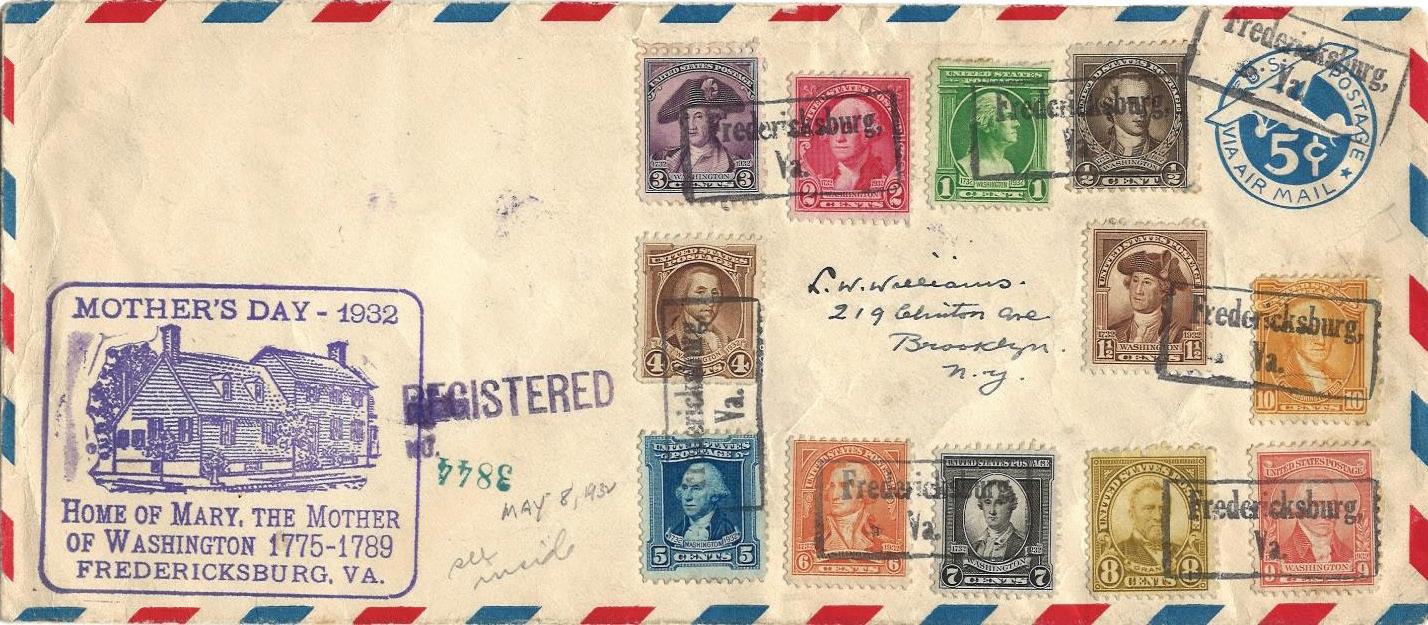
If you are a philatelic author seeking assistance with your research, drop us an email at LetterToTheEditor@stamps.org, subject line “Author’s Inquiry.” Please keep your message to under 100 words. These will be published on a space-available basis and at the discretion of the editorial department.
Headsville Smithsonian Cancels
Author interested in documents, covers, or scans of cancels and postmarks used at the Headsville Post Office when it was at the Smithsonian. Author has an article from Machine Cancel Forum (January 2006) about the flag cancellations that were used at the P.O. at the Smithsonian until 1989, and has covers with examples of all of those cancellations. Author is looking for information on any cancellations that were used from 1989 until 2006.
Ron Breznay ronbreznay47@gmail.com1932 Mother’s Day event cover
I am researching 1932 Mother’s Day event covers that were mailed from Fred-
ericksburg, Virginia to collectors residing predominately in the New York City area.
The cachet is a rubber stamp design of the Mary Washington house in Fredericksburg. The words include “Mother’s Day – 1932, Home of Mary, the mother of Washington.”
My goal is to identify who sponsored the cover (see example above). I’m especially interested in the addressees and the envelopes used for the cover, including the corner card and cachet. Please write to me at dartster57@comcast.net.
Art LizotteFort Collins, Colorado
A stamp that shows a Scott catalog?
I once came upon a stamp, or a set of stamps, depicting the Scott Standard Postage Stamp Catalog. I no longer recall the issuing country or any other information. Perhaps a reader can help. Contact editor@stamps.org, subject line “Author’s Inquiry Scott catalog” if you can help.
Jack Denys Somerville, New JerseyThe Clearinghouse lists philatelic literature for sale or wanted by PLR readers. The number at the beginning of each item identifies the prospective seller or buyer. The names and contact information for the sellers and buyers appear at the end of the Clearinghouse. Please write directly to the buyer or seller, not to the APRL, unless the APRL itself is the seller/buyer.
Pricing: The cost for each item is $3 per listing with a maximum of 10 items per submission. Items selling for greater than $100 are $7 per listing. Please write no more than three lines per listing. Please list only one book or periodical title per item; however, several issues of one journal or auction catalog may be listed as one item. PLR reserves the right to reject any listings submitted.
ABBREVIATIONS: HB - hardbound, SB - softbound, PB - paperback, PC - photocopy, LL - loose-leaf, CB - comb bound, CC - card cover, DJ - dust jacket, w/PR- with prices realized, MO - make offer, OBO - or best offer, POR - price on request.
Send Clearinghouse listings to Scott Tiffney, 100 Match Factory Place, Bellefonte, PA 16823; or email Clearinghouse@stamps.org. The deadline for each quarter's issue is the 15th day of the first month of the quarter: January 15, April I5, July 15, and October 15.
Philatelic Literature for Sale
Philatelic Literature for Sale
1. The Postal History of the AEF, 1917-1923 edited by Theo. Van Dam. HB, 242 pages, 1980. A terrific reference for of WW-I postal history of Allied Expeditionary Forces. Illustrated with narrative on the postmarks, censor markings, and auxiliary marking of the AEF mail. $50
1. Postal History of American POWs: World War II Korea Vietnam by Norman Gruenzner. HB, 138 pages, 1979. Provides a brief history of POW mail and much detail on POW mail to and from various camps for the three wars. Cover wear. $20
1, Black Heritage First Day Cachet Cover Catalog by John Barbour. SB, 170 pages, 1999. First edition Useful catalog for the collector of Black History and FDCs. Includes prices. $25
1. United States Internal Revenue Tax-Paid Stamps Printed on Tin-Foil and Tobacco Wrappers by John Alan Hicks. HB, 217 pages, 1988. A history and catalog of tobacco products tax paid stamps and wrappers. Great details and scarcity. Only 600 copies produced. $75
1. The Philatelic Exhibitors Handbook by Randy L. Neil & Ada M. Prill. SB, spiral, 312 pages, 2006. 3rd Edition. Very detailed. Great illustrations and explanations of the exhibiting techniques. $25
1. United States Patriotic Envelopes of World War II by Lawrence Sherman. HB, 430 pages, 2006. Outstanding reference for the collector of WW-II patriotics. Provides cachet details, their makers, hundreds of color examples. $75
1. Showcasing Your Stamp Collection by C.E. Foster. HB, 116 pages, 1978. An outstanding reference for the philatelic exhibitor covering all phases of exhibiting. Well-illustrated and explained. $20
1. Transportation Issue Plate Number Coil Stamps and other Plate Number Coil Issues by Joseph Agris. HB, 331 pages, 1987. Best reference for this popular area. Great history and details on each stamp. $75
1. Postmarks Cards and Covers: Collecting Postal History by Prince Dimitry Kandaouroff. HB, 188pages, 1973. Great coverage on numerous areas of global postal history. A guide to advance from collecting stamps to studying real uses of mail. $25
1. U.S. Booklets and Booklet Panes, 1900-1978, Volume 1: Flat Plate Regular Issues by Donald B. Littlefield & Sam Frank. SB, 264 pages, 2004. Excellent reference for U.S. specialist. $50
2. United States Mail and Post-Office Assistant by the Collectors Club of Chicago. HB, 577 two-volume set in black slipcase (Vol 1: Oct 1860 - Sept 1866; Vol. 2: Oct 1866 - Sept 1872). Reprinted by CCC in 1975. excellent condition. $250
3. Encyclopedia of Plate Varieties on US Bureau-Printed Postage Stamps by Loren C. French. HB, 337 pp., 1979. Published by the Bureau Issues Association. The definitive reference for the Bureau collector. $60
3. Railroad Postmarks of the United States, 1861 to 1886 by CL Towle & HA Meyer, HB, 379 pp., 1968. Published by The US Philatelic Classics Society, Inc. A catalog of Railroad mail routes and markings, fully illustrated. With plain dust jacket. $45
3. Confederate Postal History edited by Francis J, Crown, Jr. HB, 313 pp., 1976. Published by Quarterman Publications. An anthology from the Stamp Specialist. With dust jacket protected by a plastic sleeve. $90
3. The Encyclopedia of British Empire Postage Stamps, Volume III, The Empire in Asia, HB,559 pp., Published by Robson Lowe. The classic work for British Post Offices in the Middle East, South Central Asia, and the Far East, up to 1950. $75
4. American Philatelic Congress Book. Assorted annual hardbound volumes available. Inquire for availability. $20
4. American Philatelic Congress Book, 24th Edition 1958, HB. 189 pages. Topics include Lowell MA Express & Letter Offices, Haiti, Canal Zone, French Colonies, West Indies, Malta, Confederate Navy Covers and more. $25
4. American Philatelic Congress Book. 2nd Edition 1936, reprinted in 2005 by APC, comb binding, 64 pages. Topics include Revenue Stamped Documents, George Silver Jubilee Issues, Side Lights on Air Mail History and more. $15
4. United States Postage Stamps of the Twentieth Century, Volume 4. HB, 1938, 309 pages. Slight foxing on first and last few pages. Complete history, descriptions, & illustrations of commemorative stamps 1933-1937. $20
4. Printing Postage Stamps by Line Engraving by James Baxter. HB, 1939. 164 pages. First edition with heavy foxing on a handful of front and back pages, rest of book is clean. $15
4. Abraham Lincoln Illustrated Envelopes and Letter Paper, 1860 - 1865 by James Milgram. HB, 1984. 272 pages. Many illustrations. Very fine condition. $15
4. American Stampless Cover Catalog by E.N. Sampson. HB, 3rd edition, 1978, 280 pages. Very fine condition. $10
4. Byways of Philately, Privately Owned Posts and Early Locals. HB, 1966, 271 pages. Dedicated in memory of Warren Hale. Edited by Elliott Perry and others. Lots of content on Hussey local post and a few others. Nicely illustrated. Fine condition. $20
4. William H. Gross Collection 1847 and 1851-1856 Issues. Siegel Auction Gallery Sale 1041, April 9, 2013. HB. 238 pages. Color illustrations. No prices realized. $20
4. Opinions - Philatelic Expertizing - An Inside View : Volume 1. HB, 1983. 141 pages. Published by the Philatelic Foundation. Excellent condition, dust jacket slightly dirty. $20
5. The Development of Rates Of Postage by A.D. Smith. HB, 1977 reprint of 1917 original, 431 pages. Historical analytical study of the history of postage rates. Good condition.
5. Philatelic Forgers by Varro E. Tyler. HB w/ dj, 1976, 60 pages. Includes stories with illustrations about stamp forgers, their lives and the stamps they forged. Good condition.
5. Peruvian Civil Aviation Moll by H. Herbert. SB, 86 pages, 2000. Through airmail history of Peru including maps and covers. New condition.
$10
$5
$20
5. Stamp Collecting - Philatelic Terms Illustrated by James Mackay. SB, 188 pages, 1987. Profusely illustrated, Includes terms used to identify various physical characteristics of stamps. Like new. $15
5. The Postal Markings of the Canal Zone by Lawson Entwistle. SB, 262 pages, 1982. Discusses the development of the classification of Canal Zone postal markings. Slight cover wear. $20
5. The Postal History of the Forwarding Agents by Kenneth Rowe. HB, 280 pages, 1984. Describes the origins of these services and their history. Signed by author, new condition.
$15
5. Postal Markings of United States Expositions by William Bomar. HB, 206 pages, 1986. Illustrates and describes the history of exposition postal cancels. 1st ed., new condition. $20
5. Straightline, Fancy & Unusual Cancels & Handstamps on Confederate General Issue Stamps by Conrad Bush. HB, 90 pages, 1997. Depicts the cancellations used with maps and locations. Includes errata, new condition. $25
5. The Pioneer Airplane Mails of the United States by Thomas O'Sullivan. HB, 338 pages, 1985. Study of the mails carried by airplanes in the United States between 1910-1916. New condition. $15
5. German-English Philatelic Dictionary by German Philatelic Society. SB, spiral bound, 298 pages, 2005. Comprehensive reference for those needing English translations of German philatelic terms. Over 8,700 terms translated. Good condition.
1. Gerry Robbins, P.O. Box 89, Bellefonte, PA 16823-0089 – E-mail: gerry.robbins@ cox.net. Phone: 703-628-4858. Shipping and handling extra at current rates.
Expect mail delays due to USPS issues resulting from COVID-19 issues and their revised delivery policies.
2. Melanie Rogers. Email: mrogers93@hotmail.com. Phone: 312-593-7909. Shipping included.
3. Larry Oliver, 4801 Hardwick Road, Charlotte, NC 28211, stamper707@gmail.com. Postage extra, all will be sent by USPS Media Mail.
4. Mike Lampson, PO Box 471963, Charlotte NC 28247 - Email: mike@lampson.us. S hipping only to U.S. addresses. All items are postpaid. 20% discount if buying 3 or more books.
5. American Philatelic Research Library, 100 Match Factory Place, Bellefonte, PA 16823. Phone: 814-933-3803 ext. 240. Email: library@stamps.org. Shipping extra.
$10
As a specialized library with a collection that is comprised of roughly 90% donated materials, your charitable and thoughtful contributions of literature help the APRL to grow the size and scope of the collection for members and library patrons. This continued growth enables us to maintain the APRL as the world’s largest and most complete worldwide collection of philatelic literature. If interested in donating literature to the library, please contact us at library@stamps.org.
The following individuals and institutions made donations of philatelic literature to the American Philatelic Research Library in the fourth quarter of 2021 (October – December).
Carl W. Behrend Jr., Robert M. Benninghoff, Joseph Berkovits, Brian J. Birch, Patricia Bonnell, Joseph P. Bouffard, Andrew Boyajian, Thomas W. Broadhead, George W. Brown, Bryce Burke, Donald A. Chafetz, Helen M. Ciesla, Anneke de Boer, Lloyd A. de Vries, James R. Dimond, Wolfgang Fieldler, Cheryl R. Ganz, Robert L. Glass, Edward J. J. Grabowski, Igor Grigorian, John B. Hayhurst, Elizabeth M. Hisey, Daniel C. Holsenbeck, Albert E. Hopkinson and Keith W. Johnson.
Also, James E. Lee, Ronald E. Lesher, H. James Maxwell, Hector R. Mena, Elaine B. Nyberg, Theresa S. Palombo, Bohdan O. Pauk, Ellen S. Peachey, Robert Pellegrini, Stephen Reinhard, Stephen A. Rose, Vincent A. Ross, Royal Philatelic Society
London, Larry R. Sell, James Neil Steckley, Robert W. Stewart, Clarence A. Stillions, Ronald E. Strawser, Harvey G. Tilles, Alan Warren, Brian Warren, Jason Webber and David S. Zubatsky.
What’s YOUR favorite philatelic publication? We invite PLR readers to share their favorites with fellow philatelic literature enthusiasts. The publication can be old or new, common or rare. What is important is that you deem it worthy of inclusion on your bookshelf. Please contact Scott Tiffney at 100 Match Factory Place, Bellefonte, PA 16823, by e-mail stiffney@stamps.org, or by telephone 814-9333803, ext. 246 with any questions or to submit your essay.
The PLR publishes information received about new philatelic books. Send information about recent or upcoming publications for inclusion to Scott Tiffney at stiffney@stamps. org or to 100 Match Factory Place, Bellefonte, PA 16823. The descriptions given herein are compiled from source material and often are directly taken from source descriptions.

Learn African American History While Collecting U.S. Postage Stamps by Sherrod Gresham Jr. Softcover, 112 pages, 8½ by 11 inches. Published by author, December 2021. ISBN: 979-8-58504258-4. Price $19 available from amazon. com.
Combining history and philately, this book provides an informative introduction to the African American experience as pictured on U.S. postage stamps. It is a valuable guide for the novice collector of African American philatelic materials (stamps, first day covers and postcards). The stamp pages are a means of collecting and displaying the achievements and contributions of African Americans on stamps in a categorized form (i.e. inventors, educators, scientists, entre-
preneurs, musicians, writers, athletes, etc.). There are more than 200 stamps listed by name and Scott number.
The Story of the Austrian Post up to 1850 by Andy Taylor, FRPSL, Roger Morrell & Keith Brandon. Hardbound, 380 pages, 8½ by 11 inches. Published by Austrian Philatelic Society, 2022. Price £32 for members (approx. $44 U.S.) plus shipping and £39 non-members (approx. $53 U.S.) plus shipping, available from austrianphilately.com.
This work describes the development of the post in the Austrian Empire up to the introduction of postage stamps. It includes for the first time many of the original

postal decrees translated into English. The book has been created to mark the tercentenary of the 1722 Postal Decree by which Emperor Karl VI took back control of the postal system from the Paar and Thurn & Taxis families.
The work is limited to pre-stamp philately (and the accompanying history) of the European lands ruled by Kaiser Karl VI and his successors. Some parts of the book are based upon articles which previously appeared in the Austrian Philatelic Society’s journal, Austria, but the vast majority of the content has been newly written. The bulk of this book concerns itself with the Erblände, the Habsburg hereditary lands. It also includes a considerable amount of history and geography as well as some economics.
The British South Africa Company King George V Admiral Stamps 1913 To 1924 by David Spivack FRPSL & Stephen Reah-Johnson. Hardbound, 300-plus color pages, 21 by 30 cm.. Published by the Royal Philatelic Society London, 2021. ISBN 978-1-913015-16-9. Price £52
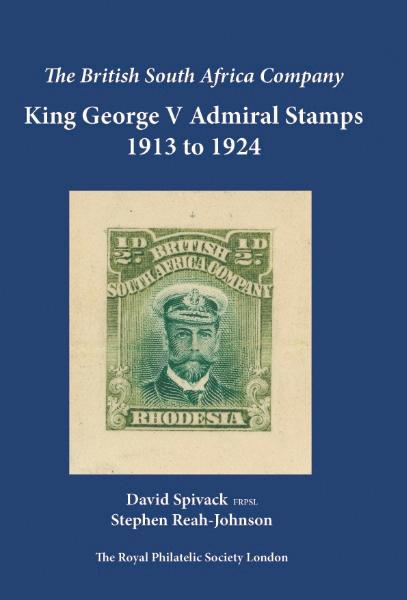
RSPL members (approx. $71 U.S.) and £58 non-RSPL (approx. $79 U.S.), shipping included within UK and Europe; £10 elsewhere, available from www.rpsl. org.uk/shop.
This book provides an in-depth review of, and research into, the British South Africa Company’s King George V Admiral stamps and postal stationery issued between 1913 and 1923, one of the most intriguing definitive series of the British Empire.
In addition to exploring the development of the design, essays, die proofs and color trials, there is a focus on the production issues that resulted in the many plates, states and colors of the Admiral stamps over its 11-year history.
The authors have reviewed both the philatelic history of, and research into the Admirals, resulting in a detailed analysis of the plates, states, printings, colors and flaws of the 19 values that constitute the series. An understanding of the role of provenance and rarity is also included, examining trends that have had an impact on selected Admiral rarities. In addition, a full review of the issued Admiral postal stationery is provided. Completing the work is a unique specialized catalog and rarity guide based on auction results of the Admiral stamps and postal stationery over the years.
Early BWI Covers Perkins Bacon Adhesives – Barbados by Peter Ford FRPSL. Softcover, 8½ by 11 inches, 236 pages.
Published by the British West Indies Study Circle, 2022. Price £26 for BWISC members (approx. $35 U.S) plus shipping, £28 non-members (approx. $38 U.S. plus shipping), available from bwisc.org/publications.
The extensive list of early BWI covers with Perkins Bacon adhesive issues compiled in this resource emanates mainly
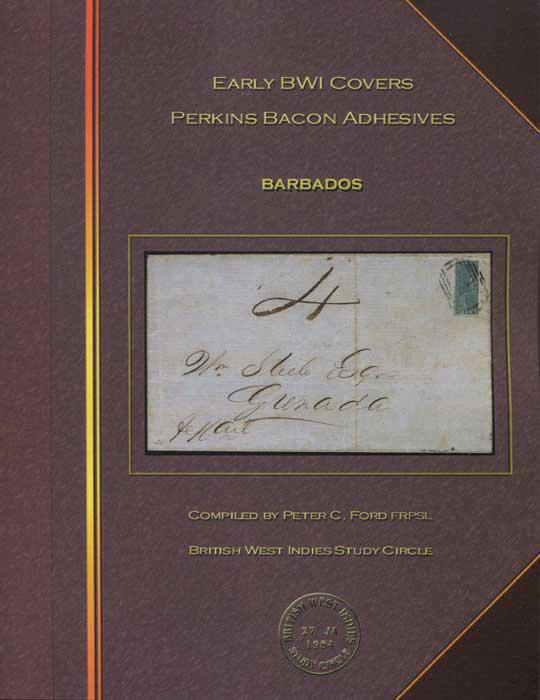
from the collections of BWISC members Michael Hamilton, Fitz Roett, Charles Freeland, FRPSL, and Peter Longmuir, as well as those of other collectors, dealers and auctions houses. The most comprehensive inventory to date, it presents a detailed illustrated listing of all recorded covers in chronological order.
Canadian First Day Covers by Artopages by Gary Dickinson. Softcover, spiral bound, 8½ by 11 inches, 62 color pages.
Published in October 2021 by the British North American Philatelic Society in memory of Horace H. Harrison. ISBN 978-1-989280-27-0. Price $27 Cdn. (approx. $21 U.S., plus shipping), available from Longley Auctions, PO Box 620, Waterdown, ON L0R 2H0, Canada, and at longleyauctions.com.
Between 1967 and 1976, beginning with the Canadian Flag stamp of January 1967 and the Centennials and continuing until the Montreal Olympics stamps of 1976, a partnership of an artist / designer and an entrepreneur interested in first day covers, who had a small printing press in his base-

ment, combined to produce 245 different first day covers for Canadian stamps of the period. The company was called Artopage Covers. This work provides a comprehensive listing of these FDCs, many featuring the same stamp, but with color differences in the FDC design.
Canada Post Office Replacement and Publicity First Day Covers by Andrew Chung & Robert D. Vogel. Softcover, spiral bound, 8½ by 11 inches, 122 color pages. Published in October 2021 by the British North American Philatelic Society in memory of Horace H. Harrison. ISBN 978-1-989280-26-3. Price $36 Cdn. (approx. $28 U.S., plus shipping), available from Longley Auctions, PO Box 620, Waterdown, ON L0R 2H0, Canada, and at longleyauctions.com.
As part of its service, the Canada Post Office would replace lost or damaged first day covers with covers carrying a different cachet. The post office also sent specially prepared FDCs to a variety of important and influential individuals throughout the world. These covers, and the enclosures they often contained, are documented in

this catalog. The detailed listings do not include valuations, but the catalog does include two additional chapters that discuss first day cancellations (1949 to 1974) and types of envelope watermarks.
First Day Covers of the 1942 Canada King George VI War Issue by Donald J. Leblanc. Softcover, spiral bound, 8½ by 11 inches, 334 color pages. Published in October 2021 by the British North American Philatelic Society, in memory of Horace H. Harrison. ISBN 978-1989280-25-6. Price $64 Cdn. (approx. $50 U.S., plus shipping), available from Longley Auctions, PO Box 620, Waterdown, ON L0R 2H0, Canada, and at longleyauctions.com.
Because of the outbreak of the Second World War, Canada did not issue any new stamps between the Royal Visit stamps on May 15, 1939 and July 1, 1942. At that time, and into 1943, a completely new set of definitive stamps, 19 in all including coil stamps, were released.
In keeping with the gravity of the world situation, the lower values of the set depicted King George VI in different military
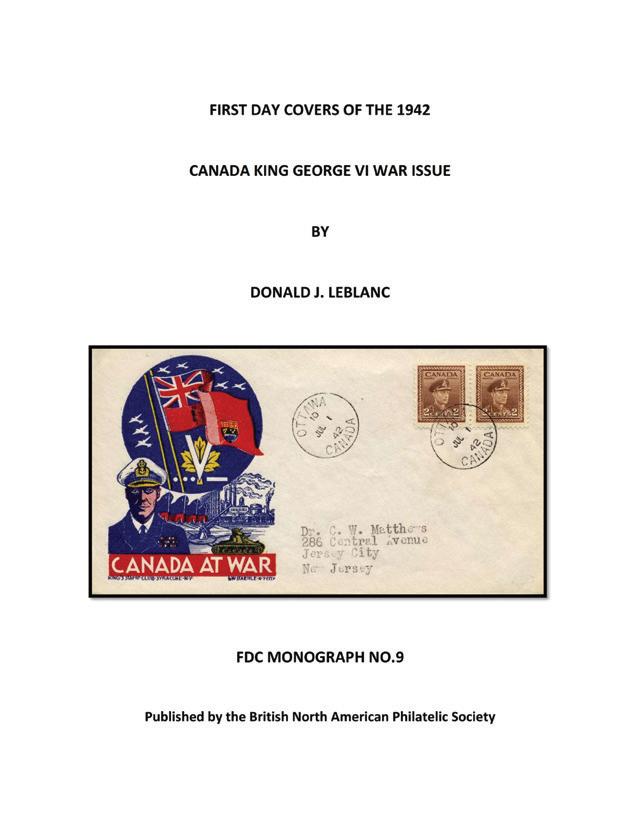
uniforms and the higher values displayed different aspects of the war effort in the country. The author notes that the number of different first day covers prepared for the War Issue was considerably less than those prepared for the Royal Visit.
The book is divided into sections covering FDCs showing the stamps bearing the king’s image, covers with different patriotic themes, an interesting selection of handdrawn covers, general purpose FDCs, covers promoting War Savings and Victory Bonds, and many business corner card FDCs.
Border Problems – Re-Entries, Retouches and Disintegration of the Two Cent Numeral Plates 11 and 12 by Peter Spencer. Softcover, spiral bound, 8½ by 11 inches, 202 color pages. Published in October 2021 by the British North American Philatelic Society in memory of Horace H. Harrison. ISBN 978-1-989280-24-9. Price $48 Cdn. (approx. $38 U.S., plus shipping), available from Longley Auctions, PO Box 620, Waterdown, ON L0R 2H0, Canada, and at longleyauctions.com.
This work is the latest volume in author’s series on the plating of Canada’s Queen Victoria Numeral Issue, and the newest on

specific aspects of the two-cent value of the issue. Having identified four distinct states of border areas of plates 11 and 12, the author shows how to detect and distinguish between the four states of the plates, and then shows the most interesting varieties of each state that has been found, using the detailed photographs that distinguish his books.
Guide to the Postal Stationery of Iraq (2nd Edition) by Clayton Rubec & Akthem Al-Manaseer FRPSL. Softbound, 250plus color pages, 21 by 30 cm. Published by the Royal Philatelic Society London, 2021. ISBN 978-1-913015-17-6. Price £23 RSPL members (approx. $31 U.S.) and £25 non-RSPL (approx. $34 U.S.), shipping included within UK and Europe; £10 elsewhere, available from www.rpsl.org.uk/shop.
The purpose of this book is to stimulate interest in this aspect of Iraqi and Mesopotamian philately. The authors illustrate the range of postal stationery products used in Mesopotamia from the Ottoman and British administrations, and list all postal stationery used in Iraq during
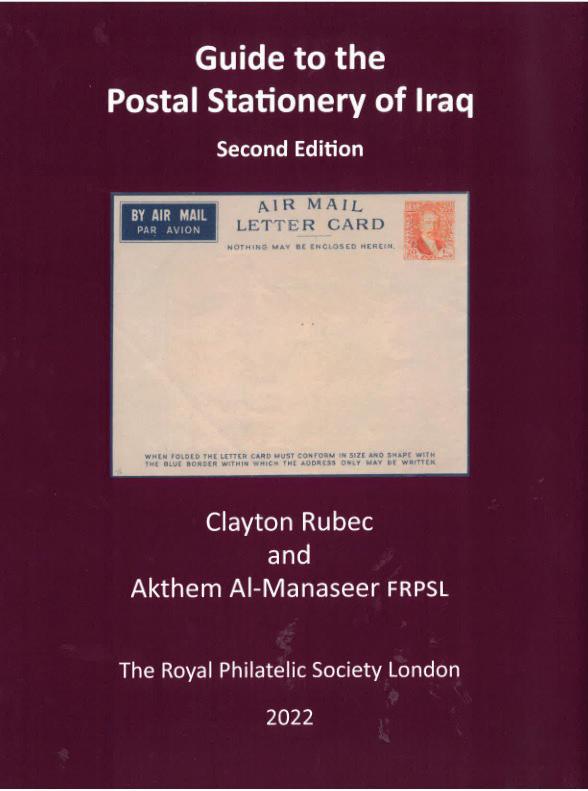
the Kingdom of Iraq and Republic of Iraq periods. Covering the period from 1863 to 2021, this second edition summarizes new information from many sources in addition to that presented in the first edition (2016). Illustrations are mainly drawn from the authors’ own collections.
Where known to the authors, specimens, essays, proofs and examples of printing errors are noted in the text. Information on forged items is included for clarity in a few sections. There are eight sections, three appendices and an index that comprise the text.
Isle of Man Local Issues by Jon Aitchison RNCP, FRPSL. Softbound, 492 color & b/w pages, 6 by 8¼ inches. Published by Tithehall Publishing, 2022. Price ₤35 (approx. $47 U.S.) plus shipping, available from Jon Aitchison, Old Tithe Hall, Start Hill, Near Bishop’s Stortford, Hertfordshire CM22 7TF, Great Britain, email britishlocals@aol.com.
This is the first catalog to cover all local issues from the Isle of Man. It includes
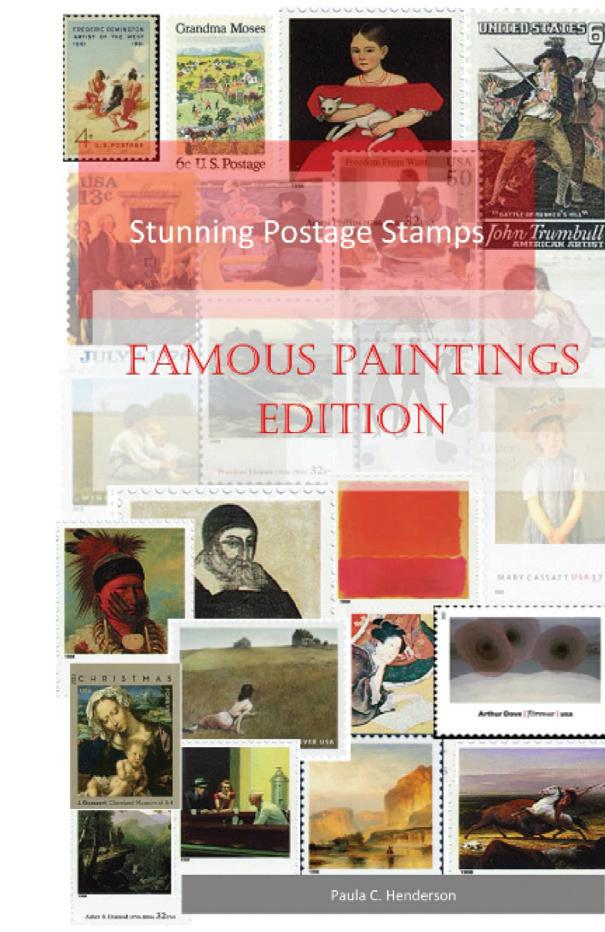
the early forerunners produced to make a case for Isle of Man postage stamps as far back as the 1930s, local carriage labels from the Calf of Man, rail and bus parcel stamps, railway letter service stamps, shipping company issues, aviation stamps including the B.E.A. letter service, strike post stamps such as Post Manninagh, tourism labels, holiday camp promotional labels, exhibition and event labels, the Knockaloe Prisoner of War stamp, savings stamps, advertising labels, carted luggage labels, newspaper transit labels, revenues including National Insurance and road tax, bogus stamps, and more. Most of this information has never appeared in print before.
The history and background of every group is explained. The catalog is in full color throughout, with 935 images including more than 850 in color. It is spiral bound so that it lies flat when open for ease of use.
Stunning Postage Stamps: Famous Paintings Edition by Paula C Henderson. Softcover, 115 pages, 6 by 9 inches. Pub-
lished by author, December 2021. ISBN: 979-8-415855-63-6. Price $15, available from amazon.com.
Meant for the novice or beginner topical collector, this book displays many worldwide issues that depict famous works of art, specifically painting. The more than 200 stamp images are in full color and many include text that details background and history concerning the paintings and the painters.
101 Cars on Stamps, Volume 1: The Art of Motor Vehicles on Postage Stamps by Ephraim Durnst. Softcover, 130 pages, 8½ by 11 inches. Published by CGR Publishing, February 2022. ISBN: 9781-592182-93-0. Price $25, available from amazon.com.
For the novice topical collector and the motor vehicle enthusiast, this book includes a colorful collection of cars and trucks on stamps from around the world. Among the motor vehicles depicted are cars, trucks, buses, ambulances, firetrucks, tractors and more. There are more than 195 depictions of international stamps devoted to this theme. Some of the classic cars and trucks included are from auto manufacturers such as Ferrari, Renault, Porsche, Mercedes, Ford, Alpha Romeo, Bugatti, Volkswagen and Audi.
101 Trains on Stamps, Volume 1: The Art of Locomotives on Postage Stamps by Ephraim Durnst. Softcover, 130 pages, 8½ by 11 inches. Published by CGR Publishing, October 2021. ISBN: 978-1592182-47-3. Price $25, available from amazon.com.
This work is a starter resource for the collector of trains and locomotives on stamps as well as the historian of railroad transportation. Profusely and colorfully illustrated, this resource includes both railway trans-

portation images from U.S. stamps as well as over 150 train images depicted on issues from around the world throughout history. More than 130 different types of trains and locomotives are depicted and in some cases in enlarged formats. Among the trains depicted are the 1934 Flying Scotsman, 1900 Orient Express, 1940 Santa Fe Super Chief, 1906 Cardean Caledonian Railway, 1825 Locomotion, 1827 Royal George New Jersey Transit, 1905 Electric Street Car and the 1832 Atlantic.
101 Fish on Stamps, Volume 1: The Art of Sea Life on Postage Stamps by Ephraim Durnst. Softcover, 130 pages, 8½ by 11 inches. Published by CGR Publishing, February 2022. ISBN: 978-1-592182-916. Price $25, available from amazon.com.
One of the more diverse and colorful topical collecting areas is the subject of this particular work, that of fish on stamps. With more than 80 full page images in color of not only fish on stamps but whales as well, this resource includes images from U.S. stamps and also those found on over 195 international issues. The fish and whales depicted in this book include hammerhead sharks, angel fish, giant squid, killer whales,
dolphins, seahorses, manta rays, catfish, great white sharks, clown fish, humpback whales, goldfish and barracuda.
The Pharmacy Postage Stamp of 1972 Honoring America's Pharmacy Professionals: The Fiftieth Anniversary of the First Day of Issue by Chris Steenerson. Softcover, 512 pages, 8½ by 11 inches. Published by author, February 2022. ISBN: 979-8415947-80-5. Price $56, available from amazon.com.
The U.S. postage stamp honoring America’s pharmacy profession was issued almost 50 years ago on November 10, 1972. This reference work tells the story of the long road taken to a postage stamp honoring America's pharmacists. The book indexes the artwork used to create a working model of the stamp, plus dies, rolls, proofs and plates, by the Bureau of Engraving and Printing. This work also lists many of the first day of issue cachets that were produced for this issue and outlines the cachet production process from sketched essays to final artwork through the production of the printing plates.

stamps.org/mighty-buck



NEW WEBSITE
Mighty Buck dollars provided last year:
• Staff laptops for remote work
• C3a online learning platform
• New website development
• Ongoing library digitalization

You and the Mighty Buck Club fund the tools that serve our members and the hobby. Let’s keep building!



APS No.
Name
Address
City ________________________________________________________________ State _____________
Recommend the PLR to your fellow researchers!
E-mail: _______________________________
ZIP/Postal Code _____________
Country _____________
• Comprehensive philatelic bibliographies
Canada
U.S.
Other or online only
$33
$42
$62
$26
$35
$21
$30
$50 $55
Type
Subscription/Membership
Philatelic Literature Review Subscription
• Indexes to other stamp periodicals
Library Sustaining Membership (includes PLR subscription)
Library Contributing Membership (includes PLR subscription)
Ages 18–39
$600 Ages 40–54
$500 Ages 55–64
$430 Ages 65+
Library Life Membership (includes life PLR subscription)
• In-depth reviews of current books & catalogs
$360 Library Patron (includes life PLR subscription)
$1,000
$5,000
Daniel W. Vooys Fellow (includes life PLR subscription)
• Philatelic Literature Clearinghouse and more!
Check box and mail with remittance to: APRL, 100 Match Factory Place, Bellefonte, PA 16823
Check Payable to APRL Visa/MasterCard/Discover
Payment:
__ __ __ Exp. Date __ __ • __ __ Verification Code __ __
Account No. __ __ __ __ • __ __ __ __ • __ __ __ __ •
Payments for PLR subscriptions/ APRL memberships in excess of the basic subscription may be tax deductible.
Date
Signature on Card
ISSN 0270-1707
American Philatelic Research Library
Match Factory Place Bellefonte, PA 16823
First